Abstract
Recently, the metabolites separated from endophytes have attracted significant attention, as many of them have a unique structure and appealing pharmacological and biological potentials. Isocoumarins represent one of the most interesting classes of metabolites, which are coumarins isomers with a reversed lactone moiety. They are produced by plants, microbes, marine organisms, bacteria, insects, liverworts, and fungi and possessed a wide array of bioactivities. This review gives an overview of isocoumarins derivatives from endophytic fungi and their source, isolation, structural characterization, biosynthesis, and bioactivities, concentrating on the period from 2000 to 2019. Overall, 307 metabolites and more than 120 references are conferred. This is the first review on these multi-facetted metabolites from endophytic fungi.
1. Introduction
The search for new metabolites for the agrochemical and pharmaceutical industries is an on-going work that needs continual optimization. Fungi are eukaryotic microorganisms that reside in almost all environmental types in nature where they have key roles in preserving the ecological balance [1,2]. Endophytes primarily inhabit their hosts without causing any harm to the hosts [3,4,5,6]. These endophytic fungi have played pivotal roles in their host’s survival through supplying nutrients and producing plenty of bioactive metabolites to prevent the danger of phytopathogenic bacteria on the host [7,8]. Endophytic fungi have gained loads of attention in natural products chemistry field due to their sustainability to biosynthesize structurally diverse and bioactive molecules, some of which are important agrochemicals and pharmaceuticals [9,10]. Isocoumarins (1H-2-benzopyran-1-ones or isochromene derivatives) are a class of biosynthetically, structurally, and pharmacologically intriguing natural products, which are coumarins isomers with a reversed lactone moiety that could possess 6,8-dioxygenated pattern, 3-(un)substituted phenyl ring or 3-alkyl chain (C1-C17) [11,12]. The oxygenation could exist at one or more of the six free positions of the isocoumarin skeleton. The oxygen atoms may be in the form of ethereal, phenolic, or glycosidic functionalities. Additionally, C-3 substituents are found more commonly on both natural and synthetic isocoumarins derivatives. Substituents that exist on the isocoumarin ring may involve alkyl, halogen, heterocyclic, aryl, or other groups [13]. Furthermore, the saturation of C-3/C-4 in isocoumarins will give 3,4-dihydroisocoumarins (DHICs) analogs (Figure 1).
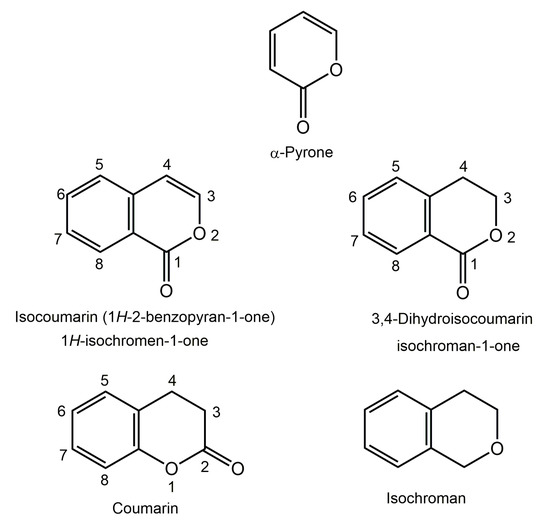
Figure 1.
Isocoumarin, 3,4-dihydroisocoumarin, coumarin, and isochroman skeletons.
Moreover, isocoumarins and DHICs possess a close relation with isochromans, they are known as isochromen-1-one and isochroman-1-ones, respectively, since the C-1 active methylene in isochromans can be easily oxidized to the related isocoumarins derivatives. Most of the natural isocoumarins and DHICs are given trivial names, which are derived mainly from the name of the species or genus of the host organisms. They have been reported from a broad scope of natural sources, including plants, microbes, marine organisms, bacteria, insects, liverworts, and fungi (e.g., soil, endophytic, and marine fungi) [14,15]. Isocoumarins are considered as important intermediates in the synthesis of a wide range of carbo- and heterocyclic compounds such as isoquinolines, isochromenes, and different aromatic compounds [16]. Thus, isocoumarin framework has been explored in various areas, including drug discovery, pharmaceutical and medicinal chemistry, and organic synthesis [13]. It has been reported that these metabolites possess various bioactivities: antimicrobial, cytotoxic, algicidal, antiallergic, immunomodulatory, antimalarial, plant growth regulatory, and acetylcholinesterase and protease inhibitors [11,17,18,19,20]. This review aims to give a highlight on the naturally occurring isocoumarins derivatives reported from endophytic fungi, focusing on the period from 2000 to July 2019. Herein, 307 naturally occurring isocoumarins derivatives have been listed most of them are reported from Aspergillus and Penicillium genera (Figure 2).
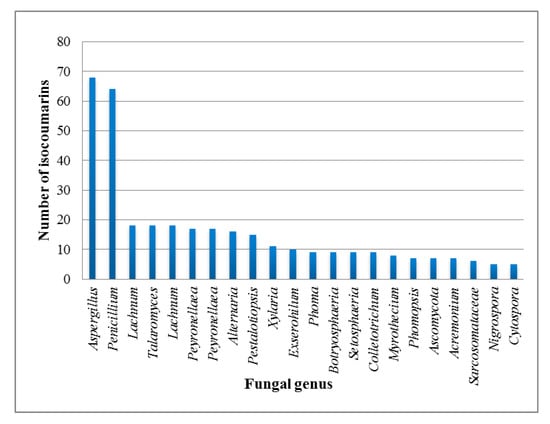
Figure 2.
Distribution of isocoumarin derivatives in different fungal genus.
The reported fungal isocoumarin derivatives are drawn according to their similarity in the isocoumarin skeleton, as well as nomenclature (Figure 3, Figure 4, Figure 5, Figure 6, Figure 7, Figure 8, Figure 9, Figure 10, Figure 11, Figure 12, Figure 13, Figure 14, Figure 15, Figure 16, Figure 17, Figure 18, Figure 19, Figure 20, Figure 21, Figure 22, Figure 23, Figure 24, Figure 25, Figure 26, Figure 27, Figure 28, Figure 29 and Figure 30).
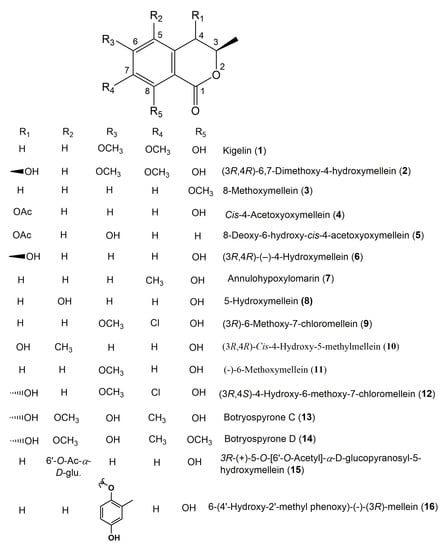
Figure 3.
Structures of isocoumarin derivatives 1–16.
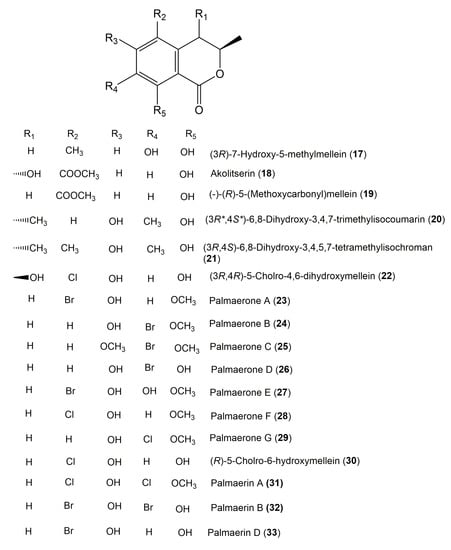
Figure 4.
Structures of isocoumarin derivatives 17–33.
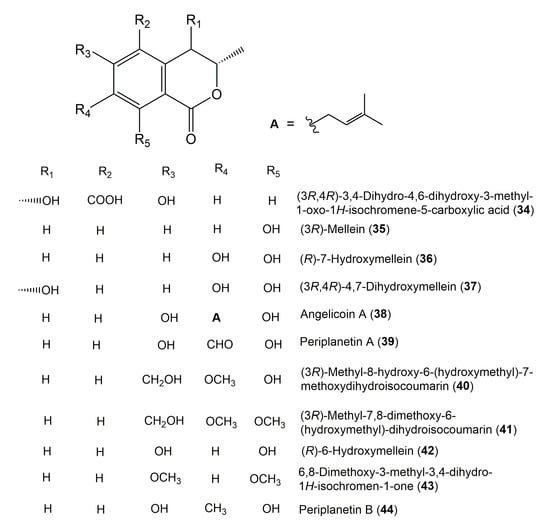
Figure 5.
Structures of isocoumarin derivatives 34–44.
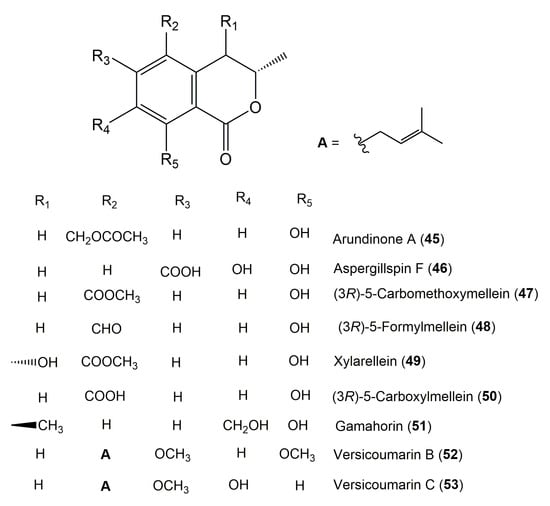
Figure 6.
Structures of isocoumarin derivatives 45–53.
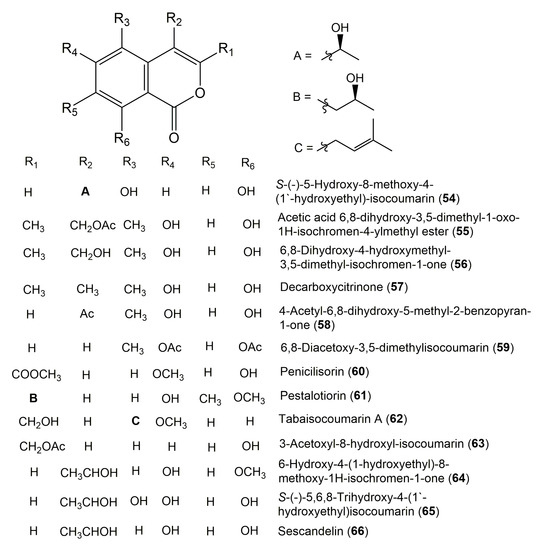
Figure 7.
Structures of isocoumarin derivatives 54–66.
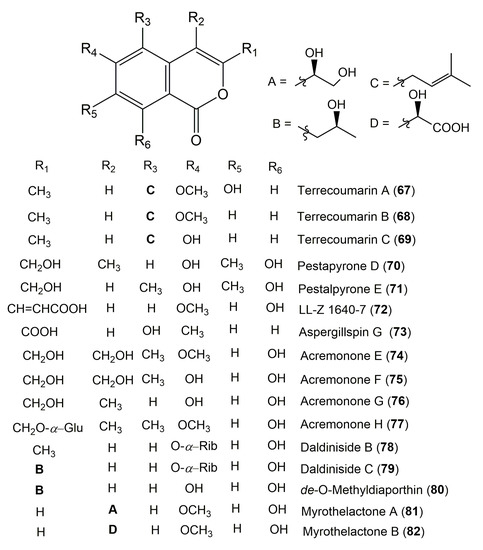
Figure 8.
Structures of isocoumarin derivatives 67–82.
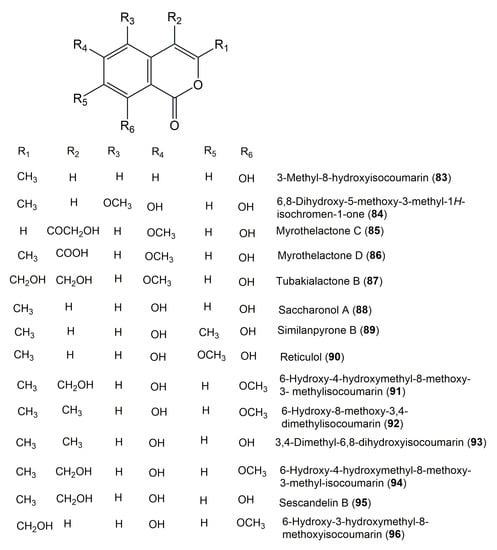
Figure 9.
Structures of isocoumarin derivatives 83–96.
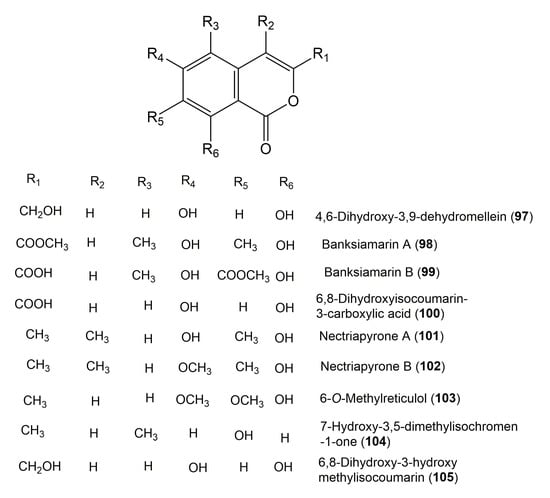
Figure 10.
Structures of isocoumarin derivatives 97–105.
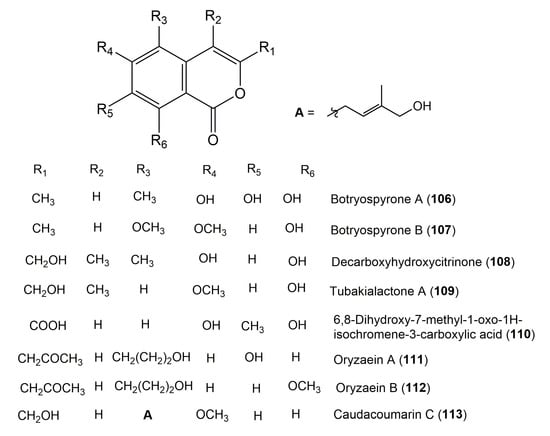
Figure 11.
Structures of isocoumarin derivatives 106–113.
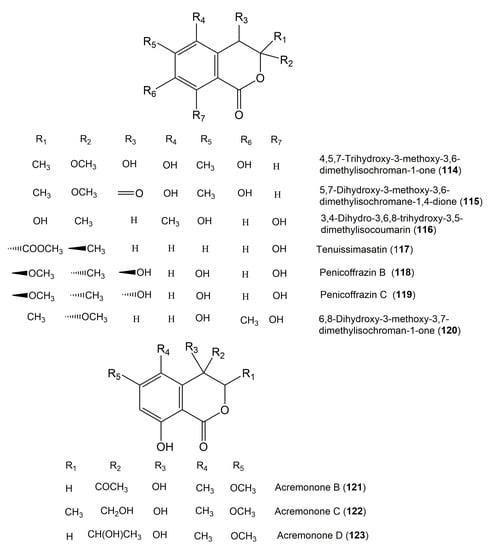
Figure 12.
Structures of isocoumarin derivatives 114–123.

Figure 13.
Structures of isocoumarin derivatives 124–136.
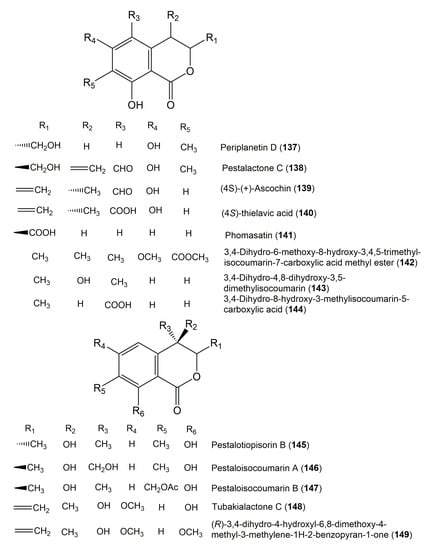
Figure 14.
Structures of isocoumarin derivatives 137–149.
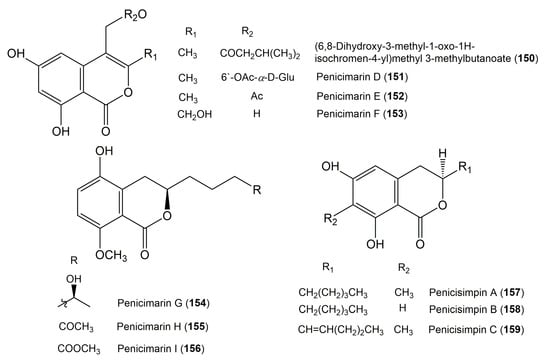
Figure 15.
Structure of isocoumarin derivatives 150–159.
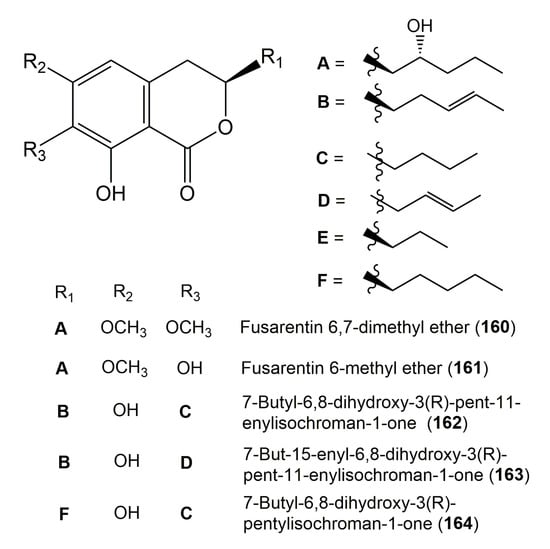
Figure 16.
Structures of isocoumarin derivatives 160–164.
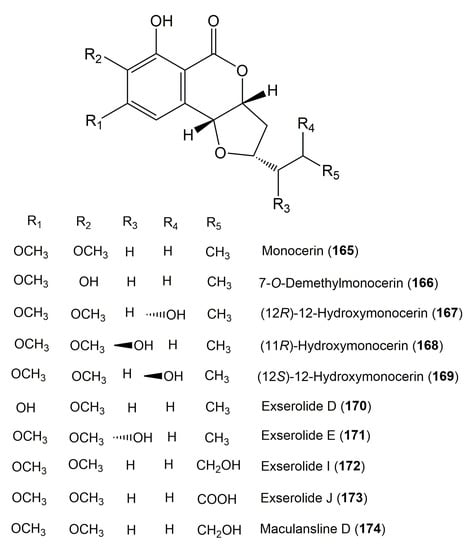
Figure 17.
Structures of isocoumarin derivatives 165–174.
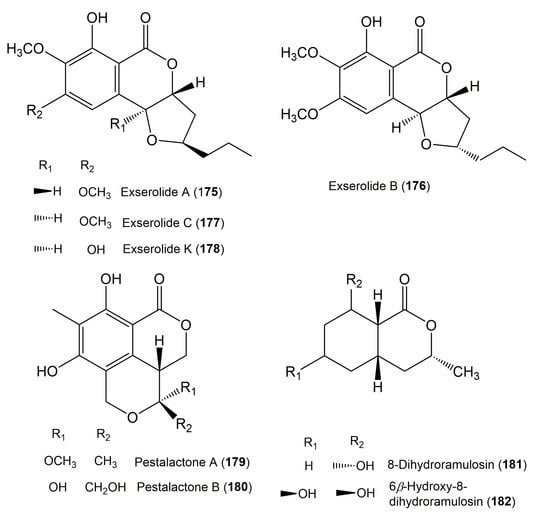
Figure 18.
Structures of isocoumarin derivatives 175–182.
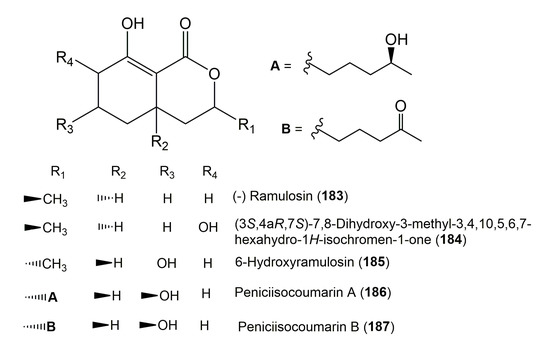
Figure 19.
Structures of isocoumarin derivatives 183–187.
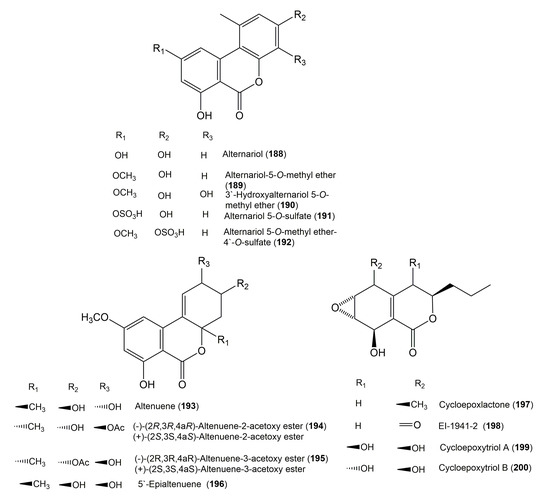
Figure 20.
Structures of isocoumarin derivatives 188–200.
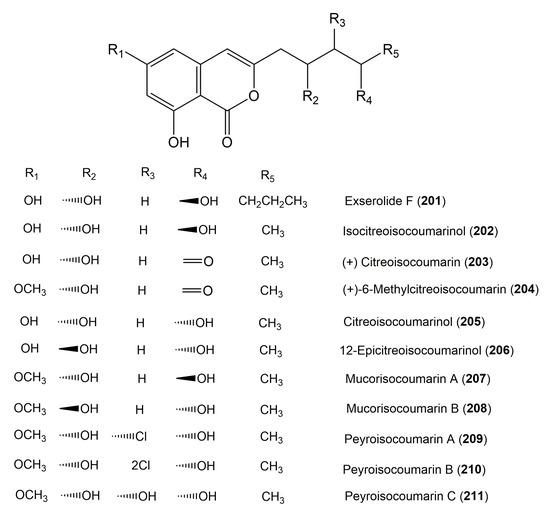
Figure 21.
Structures of isocoumarin derivatives 201–211.
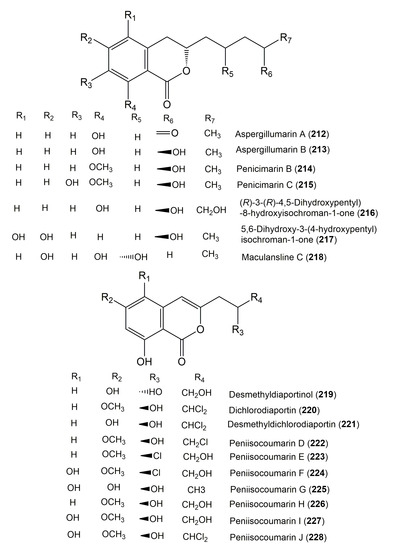
Figure 22.
Structures of isocoumarin derivatives 212–228.
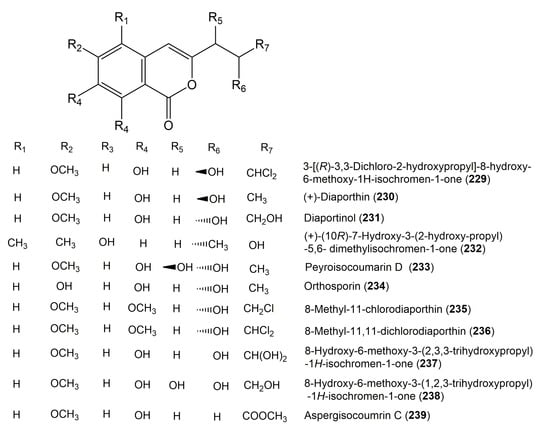
Figure 23.
Structures of isocoumarin derivatives 229–239.
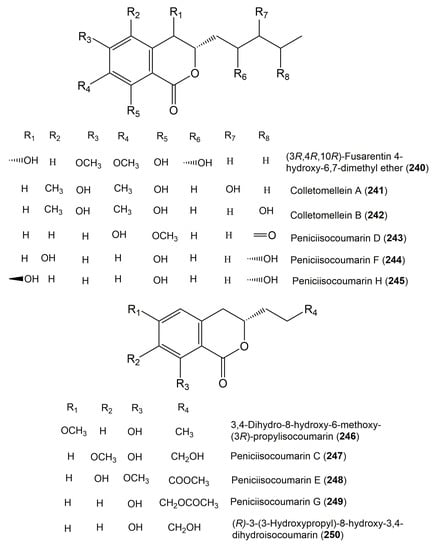
Figure 24.
Structures of isocoumarin derivatives 240–250.
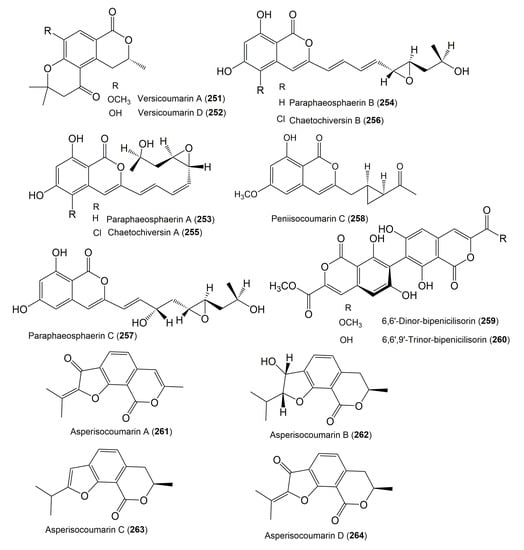
Figure 25.
Structures of isocoumarin derivatives 251–264.
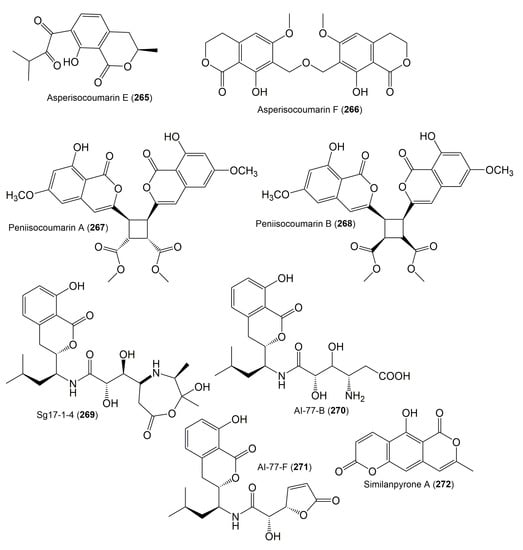
Figure 26.
Structures of isocoumarin derivatives 265–272.
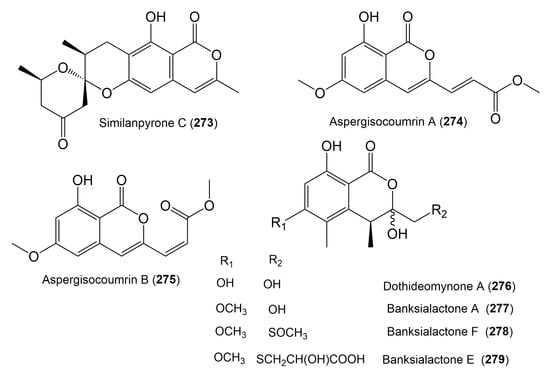
Figure 27.
Structures of isocoumarin derivatives 273–279.
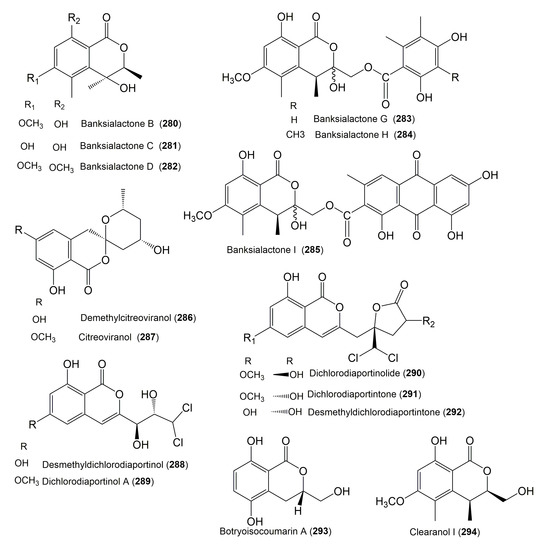
Figure 28.
Structures of isocoumarin derivatives 280–294.

Figure 29.
Structures of isocoumarin derivatives 295–300.
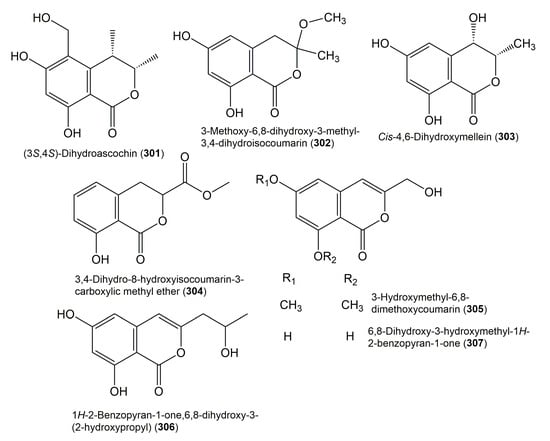
Figure 30.
Structures of isocoumarin derivatives 301–307.
It is hoped that by using these figures in conjunction with the trivial name, fungal source, host, and place (Table 1) the readers will be able to locate key references in the literature and gain much understanding of the fascinating chemistry of these metabolites. Many of these derivatives have substituents at C-3, which could be one carbon or more. The majority of them have an oxygen atom at C-8 and some have the C-6 oxygen. Further alkylation or oxygenation may occur at the remaining positions of the isocoumarin skeleton. Isocoumarins with 3,4-, 4,5-, 5,6-, 6,7-, and 7,8-fused carbocyclic rings are reported. Some of the reported derivatives have chlorine (e.g., 9, 12, 22, and 28–31) or bromine (e.g., 23, 27, 32, and 33) atom at C-5 and/or C-7. Some show sugar moieties such as glucose (e.g., 15, 77–79, and 151) and ribose moiety (e.g., 78 and 79). In addition, some isocoumarins dimers are reported (e.g., 259, 260, and 266–268). Moreover, some linked to other moieties such as anthraquinone and indole diketopiperazine (e.g., 285 and 296) or contain sulphur (e.g., 278 and 279) or nitrogen (e.g., 269–271) substituents. This review also mentions briefly their isolation, structural characterization, biosynthesis, and bioactivities (Figure 31, Figure 32, Figure 33, Figure 34 and Figure 35, Table 2 and Table 3). Strengthening of their bioactivities may draw the attention of medicinal and synthetic chemists for designing new agents using the known isocoumarins derivatives as raw materials and the discovery of new therapeutic properties not yet attributed to known compounds. The published literature search was conducted over various databases: Web of Science, PubMed, Google Scholar, Scopus, SpringerLink, ACS Publications, Wiley, Taylor and Francis, and Sci-Finder using the keywords (isocoumarin, endophytes, and biological activities).

Table 1.
List of fungal isocoumarins (Fungal source, host, and place).
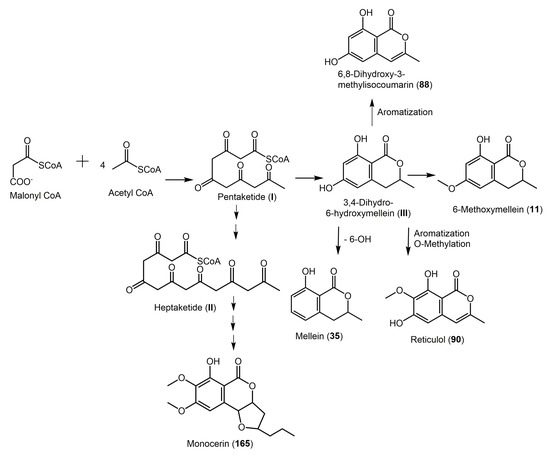
Figure 31.
Proposed biosynthetic pathway of 11, 35, 88, 90, and 165 [21,23,24,25,26].

Figure 32.
Proposed biosynthetic pathway of 56 and 125 [27].
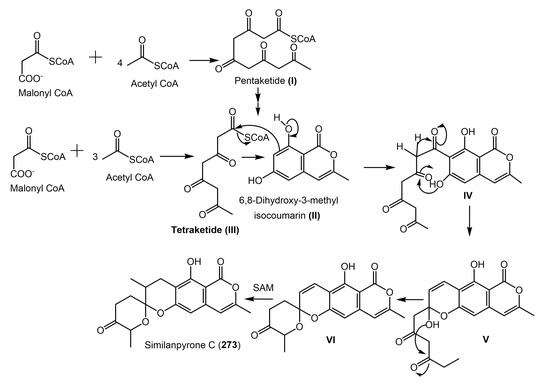
Figure 33.
Proposed biosynthetic pathway of 273 [28].
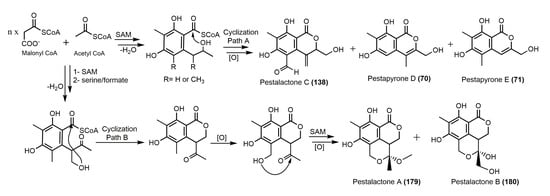
Figure 34.
Proposed biosynthetic pathway of 70, 71, 138, 179, and 180 [22].
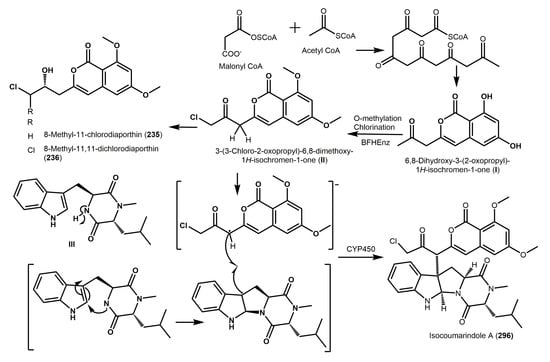
Figure 35.
Proposed biosynthetic pathway of 235, 236, and 296 [29].

Table 2.
Biological activities of the most active fungal isocoumarins.

Table 3.
Cytotoxic activity of the most active fungal isocoumarins.
2. Biosynthesis
Isocoumarin was originated of the acetate-malonate or the polyketide synthase (PKS) pathway [21,22]. Kurosaki et al. stated that 11 is biosynthesized from malonyl-CoA and acetyl-CoA through a pentaketide [23]. 3,4-Dihydro-6-hydroxymellein (III) is considered as an intermediate which would be transformed to 11 by O-methyltransferase which methylates the 6-OH group of the isocoumarin [23]. The loss of the OH group at C-6 gives rise to mellein [24]. A heptaketide II, a longer polyketone chain is implicated in 165 biosynthesis [25] (Figure 31).
Krohn et al. reported that the existence of a biosynthetic relationship between 56 and 125 [27]. They assumed that the open-chain precursor A can be directly closed to a six-membered lactone (pathway I) or cyclized after the side chain rotation through the acetyl enol tautomer to produce 56 (pathway II) [27] (Figure 32).
It was postulated that 273 is also derived from the malonate-acetate pathway [28]. The pentaketide (I) cyclization and enolization produce 88. A Claisen condensation occurs between 88 and tetraketide (II) to yield III. The side chain enolization, along with the hemiketal formation by the side chain ketone carbonyl and C-6 phenolic OH of the isocoumarin nucleus, forms a hemiketal IV. Then, the ketal formation and methylation in the side chain by S-adenosyl methionine (SAM) yield V and finally 273 [28] (Figure 33).
Moreover, Song et al. reported that an intramolecular cyclization occurs of a polyketide chain (Path A, Figure 6) [22]. The C-4 substituted derivatives have been resulted from the participation of an additional carbon unit in the cyclization (Path B, Figure 34).
Therefore, the rare isocoumarin derivatives, 179 and 180 biosynthesis differs from those of 70, 71, and 138, in which a carbon moiety (CH2OH) from formate or serine took part in the cyclization. Additionally, the 3-unsubstituted derivatives couldn’t be yielded in the biosynthesis of compounds 138 and 70; due to the C-11 oxidation is usually taking place after the polyketide chain cyclization [22]. Chen et al. postulated the biosynthetic origin of 296, an isocoumarin-indole diketopiperazine alkaloid (Figure 35) [29].
6,8-Dihydroxy-3-(2-oxopropyl)-1H-isochromen-1-one (I) was originated from the PKS pathway. It was then chlorinated and O-methylated to produce 3-(3-chloro-2-oxopropyl)-6,8-dimethoxy-1H-isochromen-1-one (II) by the catalytic effect of a bifunctional hybrid enzyme (BFHEnz). The methyl-carbonyl group of II undergoes chlorination and reduction leading to the formation of 235 and 236, respectively. Then, the hybridization of the diketopiperazine and isocoumarin units by a free radical mechanism, which could be catalyzed by cytochrome P450 giving 296 [29].
3. Structural Characterization of Isocoumarins Derivatives
Isocoumarins can be characterized by different spectral techniques such as 1D (1H, 13C, and NOE) and 2D NMR techniques (COSY, HSQC, HMBC, ROESY, and NOESY) combined with other usual methods (chemical synthesis, UV, IR, MS, etc.). However, their spectral data cannot be generalized as the data differ to a wide range relying on the type, position, number, and nature of substituents connected to the core skeleton. Furthermore, these data vary basically due to the variation of the core ring. In the compounds having isocoumarins framework, the lactone carbonyl frequency generally appears in the region 1745–1700 cm−1 in the IR. In 1H NMR, the C-3 vinylic proton appears at 6.2–7.0 ppm as a singlet or doublet for C3-substituted and unsubstituted derivatives, respectively. In 13C NMR, the lactone C=O appears in the range from 164 ppm to 168 ppm. In the 3-substituted derivatives, C-4 vinylic proton appears at 6.11–6.7 ppm as a singlet. 3,4-Dihydroisocoumarins derivatives have relatively more complicated 1H NMR spectra than isocoumarins due to C-4 and C-3 vicinal coupling and/or C-4 diastereotopic protons geminal coupling. In both derivatives, the 8-OH group appears at 10.0–12.0 ppm due to the hydrogen bonding to the C-1 carbonyl.
Mass spectroscopy is a helpful tool for the identification of these metabolites. The existence of sulfur was evident by the intensity of [M + 2]+ ion peak (∼4.5% of the molecular ion peak) [30]. Moreover, the chlorine atom in the structure was characterized by two ion peaks [M + H]+ and [M+2H]+ in a ratio 3:1 [31,32]. The relative configuration was determined by NOE, NOESY, and ROESY. The circular dichroism (CD) is usually utilized to assess the absolute configuration by comparison of the theoretical and experimental CD spectra [30,31,33]. Besides, the total synthesis provides important information and an additional confirmation for characterization of these metabolites structures. Furthermore, it allows the synthesis of analogs with improved biological efficiencies [11,34,35]. The X-ray structure crystallographic analysis of the crystalline derivatives is another tool for the absolute configuration determination. This technique could not be applied in many cases since the crystals with the required qualifications are not available because most of these metabolites do not crystallize conveniently [20,27,36]. Finally, the assignment of the absolute configuration could be done using Mosher’s method and the differences in chemical shift between the (R)- and (S)-MTPA were analyzed [33,37].
4. Methods of Extraction and Purification of Isocoumarins Derivatives
For the extraction and isolation of isocoumarins, the fungal material was extracted with CH2Cl2, acetone or EtOAc. The total extracts were partitioned between n-hexane, CHCl3, EtOAc, and MeOH or fractionated on SiO2 60 VLC using mixtures of n-hexane, EtOAc, and MeOH, or using petroleum ether, CH2Cl2, and MeOH, respectively [38,39,40]. The fractions were chromatographed over Sephadex LH-20 (CHCl3:MeOH 1:1), SiO2 CC using gradient elution of CH2Cl2:MeOH; PE:EtOAc; n-hexane:EtOAc [31,36,37,41,42,43] or RP-18 CC using MeOH-H2O (8:2, v/v) [33]. Purifications of compounds were achieved by preparative HPLC using gradient of MeOH:H2O or MeCN:H2O [31,39,40]; SiO2 CC (n-hexane:acetone:MeOH, n-hexane:acetone gradient or benzene:EtOAc) [44,45,46]; RP-18 CC (H2O:MeOH gradient) [47]. Preparative TLC could be used for compounds purification using acetone:petroleum ether (3:7) [41]; CHCl3:Me2CO:HCO2H (97:3:0.01); petrol:CHCl3 and CHCl3:Me2CO [48]; CH2Cl2:2-propanol (50:1) [49]; PE:EtOAc (1:1) [47]. Isocoumarins derivatives can be purified by recrystallization from CH2C12:CH3OH or PE:EtOAc until they showed constant melting points. These compounds can be detected on TLC by UV light or spraying reagents (vanillin-sulfuric acid or cerium-molybdenum) [27].
5. Biological Activities
5.1. Antimicrobial Activity
The isocoumarins 4 and 5 which were produced by an unidentified Ascomycete, separated from Meliotus dentatus had a potent antibacterial effect towards B. megaterium and E. coli with equal partial inhibition (PI) 10 and 9 mm, respectively compared to penicillin (PI 18 and 14 mm, respectively) and tetracycline (PI 18 and 18 mm, respectively). Furthermore, 4 and 5 exhibited prominent antifungal activities toward Botrytis cinerea, Microbotryum violaceum, and Septoria tritici and algicidal activities towards Chlorella fusca [50]. Compound 6 was tested against C. fusca, E. coli, B. megaterium, and M. violaceum using agar diffusion assay. It showed activity against C. fusca (IZD 9 mm), compared to actidione (IZD 35 mm) as well as against B. megaterium and M. violaceum with IZDs 8 and 6 mm, respectively [43]. Oliveira et al. indicated that 6 exhibited antifungal potential towards Cladosporium sphaerospermum and C. cladosporioides with detection limit 10 and 5 μg, respectively, whereas 3 showed moderate activity with detection limit 10 and 25 μg, respectively [18]. However, 8 was inactive [18]. The new isocoumarins 23–29 produced by Lachnum palmae associated with Przewalskia tangutica showed antimicrobial activities against Penicillium sp., C. neoformans, C. albicans, S. aureus, and B. subtilis (MICs 10–75 µg/mL), compared to kanamycin and amphotericin B using broth microdilution assay. It is noteworthy that 27 had potential antimicrobial potentials towards all the strains tested (MICs 10–55 µg/mL) [51]. The antifungal effect of 34 separated from Xylaria sp. and 36 and 37 separated from Penicillium sp. towards Cladosporium cladosporioides and C. sphaerospermum was assessed using direct bioautography assay [17]. Compounds 37 and 36 showed a promising effect against C. sphaerospermum and C. cladosporioides (MICs 10.0 and 5.00 μg, respectively), compared to nystatin (MICs 1.0 and 1.0 μg, respectively), while 34 had moderate effect towards C. sphaerospermum and C. cladosporioides (MICs 25.0 and 10.0 μg, respectively) [17]. Furthermore, compound 65 exhibited moderate effect towards Vibrio parahemolyticus and B. cereus with MICs 6.25 μM [52]. Furthermore, 35 exhibited only weak potential towards Botrytis cinerea (EC50 49.2 μg/mL) [53]. However, 78 and 79 showed no antifungal activity (Conc. 128 μg/mL) toward C. albicans (ATCC10231 and ATCC32354) [54]. Compounds 59, 116, 124, and 125 were tested against three fungal organisms: Eurotium repens, Mycotypha rnicrospora, and Ustilago violacae. Only 59 had a moderate potential towards all tested fungi [20]. Compound 132 was evaluated for the antimicrobial effect towards Cladosporium herbarum, Aspergillus niger, B. subtilis, and Pseudomonas syringae. The results revealed that 132 exhibited only mild activity towards B. subtilis with MIC 25 μg/mL, compared to chloramphenicol (MIC 3.13 μg/mL) [55]. The dihydroisocoumarins 154 and 155 showed selective antibacterial potential against the five pathogenic bacteria S. epidermidis, B. cereus, S. aureus, Vibrio alginolyticus, and E. coli (MICs 20, 20, 20, 20, and 20 µM, respectively for 154 and 10, 20, 20, 20, and 20 µM, respectively for 155), compared to ciprofloxacin (MICs 0.30, 0.30, 1.20, 0.60, and 1.25 µM, respectively) [56]. The antibacterial activities of 188, 189, and 193 were tested against B. megaterium, B. subtilis, E. coli, Micrococcus tetragenus, Clostridium perfringens, and MRSA S. aureus. Compound 189 had a stronger antibacterial potential (MIC 12.5 μg/mL) against B. megaterium than ampicillin (MIC 50 μg/mL). However, the other compounds did not exhibit any activity [57]. Compounds 70, 71, 138, 179, and 180 which were isolated from Pestalotiopsis sp. associated with Photinia frasery were evaluated for their antimicrobial activities towards P. aeruginosa (ATCC 9027), S. aureus (ATCC 25923), E. coli (ATCC 25922), B. subtilis (ATCC 6633), and C. glabrata (ATCC 90030). It is noteworthy that only 138 had a promising antifungal capacity against C. glabrata (MIC50 3.49 μg/mL) in comparison to amphotericin B (MIC50 0.25 μg/mL). Whilst, the other metabolites had no activity (Conc. 50 μg/mL) [22]. The antimicrobial activity of 157–159 towards different aquatic and human pathogenic bacteria (E. coli, Aeromonas hydrophilia, P. aeruginosa, Micrococcus luteus, Vibrio alginolyticus, V. parahaemolyticus, and V. harveyi) and plant pathogenic fungi (Colletotrichum gloeosprioides and Phytophthora parasitica var. nicotianae) was evaluated. They had broad-spectrum antifungal and antibacterial capacities with MICs ranging from 4 to >64 µg/mL. Compound 157 possessed the highest activities against P. aeruginosa, E. coli, V. harveyi, C. gloeosprioides and V. parahaemolyticus (MICs 4 µg/mL), whereas 158 and 159 displayed moderate activities against these microorganisms [58]. Compound 165 (Conc. 500–7.8 μg/mL) which was biosynthesized by Exserohilum rostratum isolated from Bauhinia guianensis possessed a good activity towards B. subtilis (MBC 62.5 μg/mL and MIC 15.62 μg/mL), E. coli (MBC 250 μg/mL and MIC 15.62 μg/mL), P. aeruginosa (MIC 15.62 μg/mL), S. Typhimurium (MIC 31.25 μg/mL), and S. aureus (MIC 62.5 μg/mL) [59]. Microdochium bolleyi metabolites: 165, 167, 169, and 240 were estimated for their antibacterial, antifungal, and algicidal effects toward E. coli, B. megaterium, M. Violaceum, and C. fusca using agar diffusion assay. Compounds 165, 169, and 240 inhibited the four tested organisms. It is noteworthy that 167 showed an algicidal potential towards C. fusca (IZD 6 mm, actidione IZD 50 mm and nystatin IZD 20 mm) and an antifungal effect against M. violaceum (IZD 7 mm, tetracycline IZD 10 mm and actidione IZD 35 mm), but did not have an antibacterial effect [49]. Hussain et al. stated that 197 showed potential antifungal and antibacterial activities against M. violaceum (IZD 10 mm) and B. megaterium (IZD 5 mm), respectively [42]. Compounds 165, 167–171, 175–177, and 201 were tested for their antimicrobial potential towards S. aureus (CGMCC 1.2465), B. subtilis (ATCC 6633), S. pneumoniae (CGMCC 1.1692), F. oxysporum (CGMCC 3.2830), and E. coli (CGMCC 1.2340) [60]. Compounds 167 and 177 displayed antifungal potential towards F. oxysporum with MICs 20 μg/mL, compared to amphotericin B (MIC 0.63 μg/mL). Furthermore, 201 exhibited significant antibacterial effects against B. subtilis, S. pneumonia, and S. aureus with MICs 20, 10, and 5 μg/mL, respectively in comparison to ampicillin (MICs 1.25, 10, and 0.16 μg/mL, respectively). Furthermore, it had a promising effect towards E. coli (MIC 20 μg/mL), compared to gentamicin (MIC 2.5 μg/mL) [60]. Arunpanichlert et al. reported that 213 had a mild antifungal effect against Cryptococcus neoformans and C. albicans with equal MICs of 200 μg/mL, while 212 was inactive (Conc. 200 mg/mL) [60]. Furthermore, 212 and 213 had a weak antibacterial effect against B. subtilis and S. aureus (Conc. 50 µg/mL) [61]. Chen et al. reported that the isocoumarins metabolites 54, 64–66, 84, 92–95, 150, 158, 159, 212, 213, 216, and 217 which were separated from Talaromyces amestolkiae, did not exhibit any antibacterial activity against Staphylococcus epidermidis, S. aureus, Klebsiella pneumoniae, E. coli, and B. subtilis [62]. Compounds 98, 99, 276–285, and 294 which were biosynthesized by Aspergillus banksianus, were tested for in vitro antimicrobial activities against E. coli (ATCC 25922), B. subtilis (ATCC 6633), Saccharomyces cerevisiae (ATCC 9763), and C. albicans (ATCC 10231). Compounds 283–285 displayed weak to moderate activities, whereas the other metabolites had no activity towards any of the tested strains [30]. Compound 232 showed a weak activity towards B. subtilis ATCC 6633 and Trichophyton rubrum ATCC 28,189 with MIC80 19.7 and 32.0 μg/mL, respectively, compared to penicillin (MIC80 0.9 μg/mL) and fluconazole (MIC80 1.0 μg/mL) [63]. Moreover, compounds 172, 173, and 178 isolated from Setosphaeria sp. possessed no activity towards S. aureus, Colletotrichum asianum, C. gloeosporioides, C. acutatum, Pyricularia oryza, and F. oxysporum using broth microdilution technique [64]. Compounds 72, 188, 189, 202–205, 207–211, 231, 233, 234, 286, and 287 were evaluated against Agrobacterium tumefaciens, E. coli, Ralstonia solanacearum, S. aureus, Bacillus thuringensis, Xanthomonas vesicatoria, and Pseudomonas lachrymans. The metabolite 188 showed moderate inhibitory effect towards A. tumefaciens, R. solanacearum, and S. aureus with MICs 16 μM, while 189 and 234 had weak inhibition (MICs 32 μM) against A. tumefaciens and R. solanacearum, respectively [65]. The isocoumarins 88–90 and 272 exhibited no activities (MIC > 256 μg/mL) towards P. aeruginosa, B. subtilis, S. aureus, E. coli, and C. albicans [48]. The antifungal activity of 220 and 290 was assessed using the broth dilution method. Compound 290 showed significant antifungal capacity towards Rhizoctonia solani (MIC 6.25 μg/mL), compared to carbendazim (MIC 6.25 μg/mL) and moderate effect against Colletotrichum musae (MIC 25 μg/mL), whereas 220 exhibited weak activities toward these two fungi (MICs 150 μg/mL). However, none of these metabolites was active towards Fusarium graminearum and Penicillium italicum (MICs > 200 μg/mL) [66]. Compounds 188, 193–196, 232, and 299 biosynthesized by Alternaria alternata were tested against B. subtilis ATCC 6633, S. aureus ATCC 25923, T. rubrum ATCC 28189, and C. albicans ATCC 24433. Compound 194 ([(−)- and (+)] displayed moderate effects against S. aureus (MICs 15.4 and 17.1 μg/mL, respectively), compared to penicillin MIC 1.2 μg/mL) whereas 193, 195 ([(−)- and (+)], and 196 had no prominent effect. These results demonstrated that the 2-OH acetylation could enhance the activity towards S. aureus, however, the enantiomeric difference may have a negligible influence. Furthermore, (+)-194 and (+)-195 showed promising potential towards C. albicans, while (−)-194 and (−)-195 had less activities, suggesting the difference in the antifungal potentials among the different enantiomers. Moreover, 188 possessed the highest activity towards B. subtilis (MIC 8.6 μg/mL). Whilst 232 had no activity. [63] Bai et al. stated that compounds 186, 187, 244, 245, and 248 had no antibacterial potential towards E. coli, MRSA S. aureus, S. aureus, B. cereus, Vibrio alginolyticus, and V. parahaemolyticus using microplate assay [67]. Chen et al. reported that 296 had mild activity against C. albicans (MIC 32.0 μg/mL), compared to caspofungin (MIC 0.03 μg/mL) [29]. Compounds 1, 2, and 16 demonstrated a significant potential against Trichophyton longifusus and Microsporum canis (% inhibition 45, 70, and 55, respectively and 50, and 50, and 70, respectively), compared to miconazole, (% inhibition 70 and 98.4, respectively), whereas they were inactive towards C. albicans, Fusarium solani, C. glabrata, and Aspergillus flavus using agar tube dilution technique [68]. The antimicrobial potential of 237 and 238 separated Trichoderma harzianum was investigated towards B. subtilis, E. coil, C. albicans, S. aureus, and P. aeruginosa using well diffusion technique. They had a weak inhibitory effect against E. coli (MICs 32 μg/mL), compared to chloramphenicol (MIC 4 μg/mL), whereas they were inactive towards the other tested microorganisms [69]. Compounds 46 and 73 new isocoumarins reported from Aspergillus sp. SCSIO 41,501 derived from marine gorgonian Melitodes squamata were inactive against E. coli and B. subtilis using disc diffusion technique [70]. The new isocoumarins metabolites, 13, 106, and 107 isolated Botryosphaeria ramosa were assessed for their antifungal potential towards F. oxysporum, P. italicum, and F. graminearum. Compounds 13 and 107 demonstrated a high inhibitory potential against F. graminearum and F. oxysporum (MICs 223 and 223 μM and 211.7 and 105.8 μM and respectively) in comparison to triadimefon (MICs 510.7 and 340.4 μM, respectively), whereas 106 had a significant activity against F. oxysporum (MIC 112.6 μM) and a weak effect towards F. graminearum (MIC 900 μM) [71]. Xu et al. reported that 145 displayed moderate activities against P. aeruginosa (MIC 50 μg/mL) and E. coli (MIC 12.5 μg/mL), compared to ciprofloxacin (0.078 and 0.625 μg/mL, respectively) [72]. The anti-bacterial activity of 100, 220, 239, 274, and 275 towards K. pneumonia, S. epidermidis, E. coli, S. aureus, and B. subtilis was assessed. Only 220 had activities against B. subtilis and S. aureus (MICs 25 μg/mL). While 100, 239, 274, and 275 (Conc. 25 μg/mL) did not exhibit any activity against the tested strains [73]. Compounds 162–164, novel dihydroisocoumarins isolated Geotrichum sp., associated with Crassocephalum crepidioides had been tested for the antifungal activity towards C. albicans using colorimetric technique [74]. Compounds 162 and 164 had a weak antifungal potential towards C. albicans (IC50s 13 and 33 μg/mL, respectively), compared to amphotericin B (IC50 0.01 μg/mL). Whilst 163 had no activity [74]. Compounds 51, 146, and 147 possessed antibacterial potential towards B. subtilis (MICs 100, 50, and 25 μg/mL, respectively) and S. aureus (MICs 100, 25, and 25 μg/mL, respectively), compared to ciprofloxacin (MICs 0.25 and 0.13 μg/mL, respectively). However, they were inactive against E. coli, C. albicans, C. parapsilosis, and Cryptococcus neoformans [75]. The new isocoumarins 261–266 which were produced by Aspergillus sp. 085,242 separated from Acanthus ilicifolius roots exhibited no antibacterial capacity towards Staphylococcus epidermidis, S. aureus, E. coli, B. subtilis, and Klebsiella pneumoniae [76]. Compound 297 had a moderate antifungal capacity towards Botrytis cinerea, S. sclerotiorum, Phytophthora capsici, Fusarium graminearum, and F. moniliforme (inhibition rates 18.8, 39.0, 13.7, 24.0, and 31.6%, respectively) [77]. The isocoumarins 151–153, 214, 215, and 295 had no activity against B. cereus, E. coli, S. albus, S. aureus, B. subtilis, Kocuria rhizophila, Micrococcus tetragenus, Vibrio anguillarum, and V. parahemolyticus, whereas 153 possessed weak activity (MIC 12.5 μM) against S. aureus compared to ciprofloxacin (MIC 0.160 μM) [52]. Compounds 42, 304, and 306 reported from Seltsamia galinsogisoli were assessed for the antimicrobial effect towards S. aureus, P. aeruginosa, B. subtilis, B. cereus, and K. pneumonia [78]. Compound 306 had selective activity against S. aureus (MIC 32 μg/mL), whereas 42 and 304 exhibited weak effects [78].
5.2. Cytotoxic Activity
The cytotoxic activities of isocoumarins have been assessed towards various cancer cell lines using various assays and the most active compounds have been listed in Table 3.
The cytotoxicity of 203, 219, and 221 reported from Ampelomyces sp. associated with Urospermum picroides was assessed against L5178Y (mouse lymphoma) cells using MTT assay. Interestingly, 203 had a strong cytotoxic activity with EC50 7.3 μg/mL [39]. Compound 289 isolated from Trichoderma sp. was moderately active against HepG2 and MCF-7 cell lines (IC50s 39.6 and 17.8 μg/mL, respectively) by MTT assay compared with epirubicin (IC50s 5.3 and 5.2 μg/mL, respectively) [79]. The cytotoxicity of 165 and 168 towards CHAGO, BT474, HepG2, SW-620, and KATO-3 carcinomas was estimated using MTT colorimetric assay [46]. None of these metabolites was cytotoxic (Conc. 20 μg/mL) [46]. Compounds 160, 161, 165, and 166 were evaluated for the cytotoxic activity towards HuCCA-1, HepG2, MOLT-3, and A549 [80]. They were weakly cytotoxic (IC50 115.3–153.0 μM). Interestingly, 166 possessed selective cytotoxic activity (IC50 23.7 μM) toward HepG2 cell line, compared to etoposide (IC50 15.8 μM) [80]. Arunpanichlert et al. stated that 61, 212, and 213 which were separated from Pestalotiopsis sp., had no activity towards MCF-7, noncancerous Vero cell, and human oral cavity cancer [41]. Furthermore, the isocoumarin metabolites, 3, 88, 131, 165, and 293 biosynthesized by Botryosphaeria sp. KcF6 did not have cytotoxic capacity towards MCF-7, K562, U937, A549, HeLa, HL-60, DU145, MOLT-4, and BGC823 cancer cell lines [36]. Compounds 204, 222–230, 258, 267, and 268 did not exhibit cytotoxic potential towards MCF-7, HepG2, A549, HEK293T, and HeLa cell lines [31]. Ebada et al. reported that 259 and 260 (Conc. 10 μg/mL) had cytotoxic potential against L5178Y cell line with % growth inhibition 33 and 13, respectively using MTT assay [81]. The isocoumarins 98, 99, 276–285, and 294 biosynthesized by Aspergillus banksianus were tested for in vitro activity against NS-1 cells. Compounds 283–285 displayed weak to moderate activity, whereas the other metabolites had no activity [30]. Compound 100 possessed no cytotoxicity against A2780 cell line [82]. Compounds 78 and 79, isocoumarin ribonic glycosides biosynthesized by Daldinia eschscholzii, had no obvious activity (IC50 > 40 μg/mL) towards SMMC-7721, HL-60, A-549, SW-480, and MCF-7 using the MTT assay [54]. Compounds 183 and 184 were obtained from Talaromyces sp. that inhabited Cedrus deodara, showed cytotoxic potential towards HEP-1, A-549, THP-1, HCT, and PC-3 cell lines (% inhibition 23, 15, 54, 44, and 23%, respectively for 183 and 3, 35, 40, 35, and 34%, respectively for 184) [83]. Phomasatin (141) showed no cytotoxicity (IC50 > 50 µM) against Molm 1, HL-60, and PC-3 cell lines using MTT assay [84]. Compounds 154 and 155 had no cytotoxic potential against HeLa, MCF-7, and A549 cells (IC50 > 50 µM) [56]. Compounds 157–159, dihydroisocoumarin derivatives reported from Penicillium simplicissimum were examined against Artemia salina (brine shrimp lethality). They showed brine shrimp lethality with LD50 7.7, 36.4, and 18.6 µg/mL, respectively compared to colchicine (LD50 16.5 µg/mL) [58]. Alternariol (188) was reported to prevent cell proliferation by intervention with the cell cycle. The MTT assay results of the related derivatives from Alternaria sp. indicated that all alternariol derivatives demonstrated activity toward the L5178Y, except for 190 and 192. Compound 188 was the highly active metabolite (EC50 1.7 μg/mL), whereas 189 and 191 had activity with EC50s 7.8 and 4.5 μg/mL, respectively. However, 193 was inactive [40]. Compounds 269–271 obtained from Alternaria tenuis were tested for their in vitro cytotoxicity against A375-S2 and HeLa cells using MTT assay. Compounds 269 and 271 had a potent effect with IC50s 0.1 and 0.02 mM and 0.3 and 0.05 mM, respectively. However, 270 displayed only weak activity (IC50 0.4 mM) to HeLa cells [85]. Fusariumin (298) a new isocoumarin derivative (Conc. 10 µg/mL) which was isolated from Fusarium sp. displayed a significant growth inhibitory potential against A. salina with mortality rate 78.2% [86]. Wang et al. reported that 188, 193–196, 232, and 299 were inactive (Conc. 50.0 μM) towards U2OS and HepG2 using the MTT method [63]. Furthermore, compounds 186, 187, 244, 245, and 248 had no activity towards HeLa, HepG2, and A549 cell lines [67]. Furthermore, 46 and 73 possessed no cytotoxicity towards MCF-7, HepG2, and HL60 cell lines using MTT assay [70]. Compound 296 possessed significant cytotoxicity towards AsPC-1 and MIA-PaCa-2 cell lines with IC50s 5.53 and 1.63 μM, respectively, in comparison to gemcitabine (IC50s 20.10 and 1.02 μM, respectively) [29]. Compounds 100, 220, 239, 274, and 275 were assessed for their cytotoxic effects towards HepG2, MDA-MB-435, HCT116, MCF10A, and H460 cell lines [73]. It is noteworthy that 274 had a selective cytotoxic potential towards HepG2, MDA-MB-435, MCF10A, and H460 (IC50s 43.70, 5.08, 11.34, and 21.53 μM, respectively) comparable to epirubicin (IC50s 0.32, 0.26, 0.13, 0.12 μM, respectively), whereas 275 showed a selective effect against MCF10A and MDA-MB-435 (IC50s 21.40 and 4.98 μM, respectively). However, other metabolites (Conc. 50 μM) did not affect all tested cell lines [73]. The new isocoumarin metabolite, 20 isolated from Bruguiera sexangula root-associated fungus Penicillium sp. 091,402 exhibited moderate cytotoxicity potential towards K562 (IC5018.9 μg/mL) [87]. Huang et al. reported that 142 prohibited HepG2 and Hep-2 cells growth (IC50s 55 and 52 μg/mL, respectively) using MTT method [88]. The cytotoxic potential of 252 isolated Aspergillus versicolor was estimated towards A549, NB4, PC3, SHSY5Y, and MCF7. Interestingly, it had a higher activity towards MCF7 and A549 with IC50s 8.0 and 5.8 μM, respectively [89]. The new isocoumarin, 108 isolated from Arthrinium sacchari displayed a weak cytotoxic effect towards HUVECs and HUAECs (IC50 70.8 and 277.1 μM, respectively), compared to Ki8751 (IC50s 1.0–2.0 μM) using MTT assay [90]. Compound 35 did not have a cytotoxic effect against MRC-5 and AGS cell lines [91]. Moreover, 6 possessed no cytotoxic capacity against NCIH460, MCF-7, and A375-C5 cell lines using the protein binding dye SRB method [92]. The cytotoxic abilities against A549, NB4, MCF7, SHSY5Y, and PC3 tumor cell lines of 38, 52, 53, 127, 137, 251, and 301 were tested [93]. Compound 251 exhibited a high cytotoxic effect towards MCF7 and A549 cells (IC50 3.8 and 4.0 μM, respectively), in comparison to taxol (IC50 0.1 and 0.02 μM, respectively), while the other compounds had moderate cytotoxic capacities towards some of the tested cell lines with IC50s less than 10 [93]. Compounds 23–29 were assessed for their cytotoxic capacities towards HepG2, HL-60, and SGC-7901 using MTT method. Only 27 had weak cytotoxicity towards HepG2 (IC50 42.8 µM) [51]. The cytotoxic effect of 111 and 112 towards NB4, SHSY5Y, A549, MCF7, and PC3 using MTT assay was evaluated [94]. They had moderate to weak inhibitory capacities against some tested human tumor cell lines (IC50s 2.8–8.8 µM) [94]. Penicimarins 151–153, 214, 215, and 259 had no cytotoxic activity towards HL-60, HeLa cell, A-549, and K562 cell lines [52].
5.3. Antioxidant Activity
Choudhary et al. reported that 16 had a scavenging potential against DPPH (IC50 159 μM) in comparison to PG (IC50 30 μM) and BHA, also had a powerful XO inhibitory potential (IC50 243 μM), in comparison to BHA (IC50 591 μM) and PG (IC50 628 μM), while 2 showed a weak XO inhibitory potential (IC50 707 μM) [68]. Compounds 47, 50, and 134 exhibited no antioxidant capacities in the DPPH assay [95]. However, 90 showed a moderate DPPH scavenging activity with an IC50 58 μg/mL, compared to BHA (IC50 5.5 μg/mL) [96]. Compounds 161 and 166 scavenged DPPH with IC50s 23.4 and 16.4 μM, respectively in comparison to ascorbic acid (IC50 21.2 μM) [80]. Furthermore, they prohibited the formation of superoxide anion radical with IC50 values of 4.3 and 52.6 μM, respectively in the XXO assay in relation to allopurinol (IC50 3.0 μM), whereas 165 showed no radical scavenging activities [80]. Moreover, they did not suppress the generation of superoxide anions induced by TPA in the differentiated HL-60 cells. Compounds 160, 165, and 166 showed excellent ORAC antioxidant activity (14.4, 10.8, and 11.5 ORAC units, respectively) [80]. Pang et al. reported that 172, 173, and 178 possessed no radical scavenging activity against DPPH [64]. The radical scavenging capacities of 261–266 were tested using DPPH. Only compounds 261 and 263 exhibited weak activity with EC50s 125.0 and 130.0 μM, respectively compared to vitamin C (EC50 35.0 μM) [76]. The ability of compounds 72, 188, 189, 202–205, 207–211, 231, 233, 234, 286, and 287 to regulate Nrf2, that complies to the oxidative stress by binding to ARE in the gene’s coding promoter for antioxidant enzymes and protein for the synthesis of glutathione using ARE-driven luciferase reporters in HepG2C8 cells was evaluated. Compounds 209, 210, and 233 (a dose 10 μM) produced a significant induction of luciferase 1.93–2.95 folds more than DMSO (blank control), whereas tBHQ (positive control) invigorated the luciferase activation with 4 folds more than DMSO at a dose (50 μM) [65]. Compounds 80, 88, 118, 119, 303, and 307 isolated from Penicillium coffeae were tested for their DPPH scavenging activities. Only 302 had a moderate effect (IC50 656 μM), compared to BHT (IC50 59 μM), whereas the rest compounds had no activities (IC50 > 900 μM) [47].
5.4. α-Glucosidase, Acetylcholinesterase (AChE), and Protein Kinase Inhibitory Activities
α-Glucosidase is a carbohydrase, which is secreted from the epithelium of the small intestine [97,98]. It catalyzes the degradation of carbohydrates into α-glucose thus elevating the blood glucose level [99,100]. One of the therapeutic approaches for treating diabetes is to retard glucose absorption via inhibiting this enzyme. α-Glucosidase inhibitors slow down the digestion and absorption of carbohydrates by competitive blocking of the α-glucosidase activity [101]. Consequently, the postprandial blood glucose concentration is reduced [99,100,101]. Therefore, many efforts have been made to identify α-glucosidase inhibitors from natural sources.
Compounds 54, 64–66, 84, 92–95, 150, 158, 159, 212, 213, 216, and 217 were tested for the α-glucosidase inhibitory capacity [62]. Compounds 84, 95, 93, and 212 exhibited promising inhibitory activities (IC50s 89.4, 17.2, 36.4, and 38.1 μM, respectively), better than acarbose (IC50 958.3 μM). The activity of 150, 213, 216, and 217 was five-fold more than that of acarbose. Compounds 65, 94, 66, 159, and 158 displayed moderate inhibitory activity with IC50s 315.3, 302.6, 417.8, 266.3, and 431.4 μM, respectively. Moreover, 54, 65, and 66 had weak activity, whereas the other isocoumarins had activities similar to that of acarbose [62]. Compounds 114 and 115 biosynthesized by Aspergillus sp. were assessed for their in vitro α-glucosidase inhibitory capacities. Compound 114 exhibited more efficacy than that of acarbose (IC50 553.7 μM) with IC50 90.4 μM, whereas 115 was moderately active [38]. The new isocoumarins, 261–266 were assessed for the α-glucosidase inhibitory potential in comparison to acarbose (IC50 of 628.3 μM) [76]. Compounds 262, 265, and 266 showed moderate inhibitory effects with IC50s 87.8, 52.3, and 95.6 μM, respectively [76]. Cui et al. reported that 203, 205, and 206 had a moderate inhibitory activity with IC50s 343.7, 392.5, and 538.7 μM, respectively, compared to acarbose (IC50 815.3 μM) [33]. The α-glucosidase inhibitory capacities of 204, 222–230, 258, 267, and 268 which were biosynthesized by Penicillium commune were evaluated. Compounds 224, 225, 227, and 228 possessed powerful activity (IC50 38.1–78.1 μM) than acarbose (IC50 478.4 μM). However, compounds 204, 223, and 224 were moderately active (IC50s 102.4–158.4 μM) [31]. Compound 103 which was separated from Xylariaceae sp. isolated from Quercus gilva stem, possessed α-glucosidase inhibitory potential with IC50 41.75 μg/mL, compared to quercetin (IC50 4.80 μg/mL) [102]. The in vitro glucose consumption assay of 78 and 79 (Conc. 20 μg/mL) showed no activity with DMEM-induced 3T3 fibroblasts in the anti-diabetic model [54]. The α-glucosidase inhibitory activity of 76, 81, 82, 85–88, 93, and 95 which are reported from Myrothecium sp. was investigated. Compounds 76, 81, 85, and 87 exhibited inhibitory potential towards the Saccharomyces cerevisiae expressed human-sourced α-glucosidase recombinant with IC50s 0.37, 0.32, 0.036, and 0.026 mM, respectively compared to acarbose (IC50 0.47 mM) [103]. Compounds 165, 167, 174, and 218 biosynthesized by Leptosphaena maculans did not show any inhibitory effects against α-glucosidase [104].
Acetylcholinesterase (AChE), an enzyme that catalyzes acetylcholine (ACh) hydrolysis leading to a decrease in the levels of ACh in the brain [105]. Thus, appears to be a critical element in the development of neurodegenerative diseases such as Alzheimer’s disease (AD) and dementia. The most suitable therapeutic approach for treating AD and other forms of dementia is to restore ACh levels by inhibiting AChE [106]. Compounds 3, 6, and 8 were evaluated for their AChE inhibitory activities. Compound 6 had a moderate AChE inhibitory potential with a limit of detection 30.0 μg, whereas 3 and 8 were inactive (limit of detection over 100 μg) [18]. Compounds 34, 36, and 37 showed weak inhibition of AChE with a limit of detection 10 μg in a TLC-based AChE inhibition assay [17]. Only 34 displayed moderate AChE inhibitory activity (limit of detection 3.0 μg) compared to galantamine (MICs 1.0 μg) [17].
Protein kinases are enzymes that catalyze the transfer of a phosphate group from a high energy molecule such as adenine triphosphate (ATP) to a specific amino acid. They play important roles in regulating many cellular functions, including survival, proliferation, motility, apoptosis, as well as DNA damage repair and metabolism [107]. Some of them are commonly activated in cancer cells and known to play roles in tumorigenesis [108]. Protein kinases inhibitors are anticipated to be a source of potential therapeutic targets for treating various human disorders such as neoplastic and neuroinflammatory diseases [107,108]. The isolated alternariol derivatives from Alternaria sp. were assessed for their inhibitory activities against 24 protein kinases. Interestingly, alternariol (188) and its derivatives 189–191 prohibited protein kinases: Aurora A, ARK5, Aurora B, IGF1-R, b-RAF, VEGF-R2, FLT3, VEGF-R3, SAK, and PDGF-Rbeta with IC50 below 1 × 10−6 g/mL. Moreover, 193 exhibited activity with an IC50 1 × 10−5 g/mL or less towards the various tested kinases [40].
5.5. Anti-Inflammatory Activity
Compounds 3, 88, 131, 165, and 293 were assessed for their COX-2 inhibitory activities. Only 293 exhibited significant inhibitory activity with an IC50 6.51 μM [36]. The anti-inflammatory activities of 203, 208, 220, 221, 231, 288, 289, 291, and 292 were assessed against NO production in the LPS-stimulated mouse macrophage RAW 264.7 [37]. Compound 292 had a potent inhibitory capacity (IC50 15.8 µM), whereas 220, 221, and 291 were weakly active compared to indomethacin (IC50 37.5 µM), while the other compounds had no inhibitory potential (IC50 > 100 µM) [37]. Annulohypoxylomarin A (7) derived from the endophytic fungus A. truncatum did not affect (IC50 > 100 μM) the production of TNF-α, IL-12 p40, and IL-6 in LPS-stimulated bone marrow-derived dendritic cells [45]. Compounds 186, 187, 244, 245, and 248 did not affect the NO production in LPS-induced RAW 246.7 mouse macrophages [67]. Compounds 19 and 36 biosynthesized by Xylaria cubensis associated with Litsea akoensis leaves were assessed for their capacities to prohibit IL-6 and NO production in LPS-activated RAW 264.7 cells. It is noteworthy that 36 had IL-6 inhibitory potential with IC50 9.4 μM [109]. Compounds 23 and 27 had moderate inhibitory effects on the production NO in LPS-induced RAW 264.7 cells (IC50 26.3 and 38.7 µM, respectively) with no observed toxicities at 50 µM [51].
5.6. Anti-Mycobacterial, Antiplasmodial, Antiviral, and Insecticidal Activities
Compounds 204, 222–230, 258, 267, and 268 (Conc. 50 μM) were tested for their Mycobacterium protein tyrosine phosphatase B (MptpB) inhibitory activity [31]. Compound 225 had MptpB inhibitory effect (IC50 20.7 μM), compared to oleanolic acid (IC50 22.1 μM), however, the other compounds possessed weak or no inhibitory effects at the same concentration [31]. Arunpanichlert et al. reported that compounds 61, 212, and 213 showed no activity against Mycobacterium tuberculosis [41]. Compounds 162 and 163 showed weak antituberculous potential against M. tuberculosis H27Ra (IC50s 25 and 50 μg/mL, respectively), in comparison to kanamycin sulfate and isoniazid (IC50s 0.050 and 2.5 μg/mL, respectively) using MABA, whereas 164 had no activity [74]. The antiplasmodial activity against the multidrug-resistant K1 strain of Plasmodium falciparum of 165 and 168 was estimated using microculture radioisotope technique [46]. Compound 165 showed antiplasmodial activity (IC50 0.68 μM). However, its 11-hydroxy analog (168) had a 10-fold lower activity, suggesting that the existence of the OH group in the n-propyl chain decreases the activity [46]. Compounds 61, 212, and 213 had no antimalarial activity towards P. falciparum [41]. Furthermore, 6 and 35 had no antimalarial potential against K1 strain of P. falciparum [110,111]. Compounds 98, 99, 276–285, and 294 were tested for in vitro activity against Tritrichomonas fetus (KV-1). The results revealed that 283–285 displayed weak to moderate activity, whereas the other metabolites had no activity [30]. Compounds 162 and 163 showed significant antimalarial potential with IC50s 4.7 and 2.6 μg/mL, respectively, compared to chloroquine diphosphate (IC50 0.16 μg/mL) towards P. falciparum (K1, multi-drug resistant strain) using microculture radioisotope technique [74]. However, 163 was inactive [74]. Compound 11 separated from the endophytic fungus Phoma sp. exhibited antiviral activity against influenza A virus (A/Puerto Rico/8/34, H1N1) with IC50 20.98 µg/mL, compared to arbidol (IC50 0.15 µg/mL) [26]. The anti-tobacco mosaic virus (anti-TMV) activities 39, 67–69, 96, 97, and 137 (Conc. 20 μM) produced by P. oxalicum, isolated from Nicotiana sanderae leaves was screened using the half-leaf method [44]. The results showed that 67 had the highest activity (% inhibition 25.4). While other compounds possessed weak activity with an inhibition rate ranging from 11.3 to 18.9% [44]. Duan et al. mentioned that 40 and 41 (Conc. 20 μM) had anti-TMV capacities (inhibition rates 18.6 and 21.8%, respectively) using the half-leaf technique [112]. The anti-TMV activities of 38, 52, 53, 127, 137, 251, and 301 were evaluated using the half-leaf method at a concentration 20 μM. Interestingly, 251 showed a high anti-TMV potential (inhibition rate 28.6%), compared to ningnanmycin (inhibition rate 31.5%), whereas the other metabolites had a moderate activity (inhibition rates 15.6–22.0%) [93]. Oryzaeins A (111) and B (112), new isocoumarin derivatives isolated from Aspergillus oryzae were tested for their anti-TMV utilizing the half-leaf assay at Conc. 20 µM. The results revealed that 111 and 112 had moderate anti-TMV potential (inhibition rates 28.4 and 30.6%, respectively) [94]. Antifeedant activities of 134 and 135 were evaluated against larvae of Spodoptera littoralis using glass-fiber discs. Compound 135 possessed activity at 100 ppm with feeding index 42.1, whereas 134 did not affect the feeding (feeding index 30.1) [55]. The new isocoumarins, 186, 187, 244, 245, and 248 displayed a growth inhibitory activity toward Helicoverpa armigera Hubner (IC50s 200, 200, 200, 100, and 100, μg/mL, respectively), compared to azadirachtin (IC50 25 μg/mL) [67].
5.7. Other Biological Activities
The antischistosomal activity of 6 and 35 was estimated against Schistosoma mansoni adult worms. It is noteworthy that 6 and 35 (Conc. 50 and 200 μg/mL, respectively) caused 100% death of the parasites, compared to praziquantel (Conc. 12.5 μg/mL) [113]. Compounds 6 and 131 produced by Neofusicoccum parvum, showed phytotoxic activity on tomato plants with symptoms ranging from slight to drastic wilting of leaves [114]. Nakashima et al. reported that 87, 109, 148, and 149 isolated from Houttuynia cordata leaves associated fungus Tubakia sp. ECN-111 had no agonistic activity for a liver X-receptor and peroxisome proliferator-activated receptor-C in a luciferase reporter gene assay [115]. Compounds 160, 161, 165, and 166 did not prohibit aromatase (CYP19) enzyme (IC50 15.3–16.9 μM) [80]. Compound 300 produced by Penicillium sp. possessed moderate inhibitory activity on the Arabidopsis thaliana seeds germination [116].
6. Conclusions
Endophytic fungi have been emerged as a new area for the discovery of new pharmaceutical candidates and continue to be a prosperous pool of bioactive and structurally unique metabolites. The isocoumarins and 3,4-dihydroisocoumarins ring system is present in nature with an enormous spectrum of bioactivities, extending from antibacterial to anticancer. According to this review, the distinctive pharmacological significance of these metabolites initiates much research to be done and still going on towards the advancement and synthesis of their derivatives. The inactivity reported for some derivatives in former studies could be due to prejudice in the evaluation experiments. Further assessments of these metabolites with wider spectrum screening systems are endorsed, which may lead to the invention of their interesting activities.
Author Contributions
S.R.M.I., G.A.M., S.G.A.M., H.M.A.: developed the concept for the review, wrote manuscript, and original draft preparation; A.O.N., D.M.A., A.A.B.: contributed literature search and data curation and funding acquisition: S.R.M.I., G.A.M., S.G.A.M., H.M.A.: read and approved the final manuscript. All authors have read and agreed to the published version of the manuscript.
Funding
This research received no external funding.
Conflicts of Interest
The authors declare no conflict of interest.
Abbreviations
1D: One Dimensional; 2D: Two Dimensional; A2780: Human Ovarian Cancer Cell Line; A375-S2: Human Malignant Melanoma Cell Line; A375-C5: Human Malignant Melanoma IL-1 Insensitive; A549: Human Lung Carcinoma Cell Line; AChE; Acetylcholinesterase; AGS; Gastric Adenocarcinoma Cell Line; ARE: Antioxidant Response Element; ARK5: NUAK Family SNF1-Like Kinase 1; ASPC-1: Pancreatic Adenocarcinoma Cell Line; Aurora A: Aurora A Kinase: Aurora B: Aurora B Kinase; BFHEnz: Bifunctional Hybrid Enzyme; BGC823: Kind of Human Gastric Carcinoma Cell Line; BHA: 3-t-Butyl-4-Hydroxyanisole; BHT: Butylated Hydroxytoluene; b-RAF: Proto-oncogene, Serine/Threonine Kinase; BT474: Breast Cancer Cell Line; CCK: Cholecystokinin; CD: Circular Dichroism; DPPH: 2,2-Diphenyl-1-picrylhydrazyl; CHCl3: Chloroform; CH2Cl2: Dichloromethane; CHAGO: Human Lung Bronchus Carcinoma Cell Line; COSY: Correlation Spectroscopy: COX-2: Cyclooxygenase-2; CPE: Cytopathic Effect; CYP19: Aromatase; DHICs: Dihydroisocoumarins; DMEM: Dulbecco’s Modified Eagle Medium; DMSO: Dimethyl Sulfoxide; DU145: Human Prostate Cancer Cell Line; EC50: Half Maximal Effective Concentration; EtOAc: Ethyl Acetate; FLT3: fms Related Tyrosine Kinase 3; GI: Growth Inhibition; H460: Human Lung Cancer Cell Line; HCT 116: Human Colon Cancer Cell Line; HeLa: Human Cervix Carcinoma Cell Line; HEK293T: Human embryonic kidney Cell Line; HEP-1: Hepatoma Cancer cell line; HepG2: Liver Hepatocellular Carcinoma Cell Line; HL-60: Human Caucasian Promyelocytic Leukemia Cell Line; HMBC: Heteronuclear Multiple Bond Correlation; HSQC: Heteronuclear Single Quantum Coherence; HuCCA-1: Human Lung Cholangiocarcinoma Cell Line; HUVEC: Human Umbilical Vein Endothelial Cell Line; HUAEC: Human Umbilical Artery Endothelial Cells; IC: Inhibitory Concentration; IC50: The Half Maximal Inhibitory Concentration; IGF-1R: Insulin like Growth Factor 1 Receptor; IL-6: Interleukin 6; IL-12 p40: Interleukin-12 Subunit Beta; IR: Infrared Radiation; IZD: Inhibition Zone Diameter; K562: Human Immortalised Myelogenous Leukemia Cell Line; KATO-3: Human Gastric Cancer; L5178Y: Mouse Lymphoma Cell Line; LPS: Lipopolysaccharide; LD: Lethal Dose; MABA; Microplate Alamar Blue Assay; MBC: Minimum Bactericidal Concentration; MCF-7: Human Breast Adenocarcinoma Cell Line; MCF10A: Immortalized Non-Cancer Breast Epithelial Cell Line; MDA-MB-435: Human Breast Cancer Cell Line; MeCN: Acetonitrile; MeOH: Methanol; MIC: Minimum Inhibitory Concentration; MIA-PACA-2: Pancreas Ductal Adenocarcinoma Cell Line; MOLT-3 and MOLT-4: Acute Lymphoblastic Leukemia Cell Line; Molm 13: Human Acute Myeloid Leukemia Cell Line; MptpB: Mycobacterium Protein Tyrosine Phosphatase B; MRC-5: Permanent Lung Fibroblast Cell Line; MRSA: Methicillin-Resistant Staphylococcus aureus: MS: Mass spectrometry; MTPA: α-Trifluoromethylphenylacetic Acid: MTS: One Solution Cell Proliferation; MTT: Microculture Tetrazolium Assay; NB4: Human Acute Promyelocytic Leukemia Cell line; NCIH460; Human Lung Cancer Cell Line; NMR: Nuclear Magnetic Resonance; NO: Nitric Oxide; NOE: Nuclear Overhauser Effect; NOESY; Nuclear Overhauser Effect Spectroscopy; Nrf2: Nuclear Factor E2-Related Factor 2; ORAC: Oxygen Radical Absorbance Capacity; PC-12: Adrenal Phaeochromocytoma Cell Line; PC-3: Human Prostate Cancer Cell Line; PDGF-Rbeta: Platelet-Derived Growth Factor Receptor Beta; PE: Petroleum Ether; PG: Propyl Gallate; PI: Partial Inhibition; PKS: Polyketide Synthetase; RAW 264.7: Mouse Macrophage; ROESY: Rotating Frame Nuclear Overhauser Effect Correlation Spectroscopy; RP-18: Reversed Phase C-18; SAK: Staphylokinase; SAM: S-Adenosyl Methionine; SMMC-7721: Hepatocellular Carcinoma Cell line; SGC-7901: Human Gastric Cancer Cell Line; SHSY5Y: Neuroblastoma Cell Line; SiO2 CC: Silica gel Column Chromatography; SW-620: Human Caucasian Colon Adenocarcinoma Cell Line; SW-480: Colorectal Adenocarcinoma Cell Line; TBHQ: Tertiary Butylhydroquinone; THP-1: Human Monocytic Cancer Cell Line; TMV: Tobacco Mosaic Virus; TNF-α: Tumor Necrosis Factor Alpha; TPA: 12-O-Tetradecanoylphorbol-13-Acetate; TLC: Thin Layer Chromatography; U2OS: Human Osteosarcoma Cell Line; U937: Human Macrophage (Mφ) Cancer Cell Line; UV: Ultraviolet; VEGF-R2: Vascular Endothelial Growth Factor A: VEGF-R3: Vascular Endothelial Growth Factor 3; VLC: Vacuum Liquid Chromatography; XO: Xanthine Oxidase; XXO: Xanthine/Xanthine Oxidase.
References
- Ibrahim, S.R.; Abdallah, H.M.; Mohamed, G.A.; Ross, S.A. Integracides HJ: New tetracyclic triterpenoids from the endophytic fungus Fusarium sp. Fitoterapia 2016, 112, 161–167. [Google Scholar] [CrossRef] [PubMed]
- Ibrahim, S.R.; Mohamed, G.A.; Khedr, A.I. γ-Butyrolactones from Aspergillus species: Structures, biosynthesis, and biological activities. Nat. Prod. Commun. 2017, 12, 791–800. [Google Scholar] [CrossRef] [PubMed]
- Ibrahim, S.R.; Elkhayat, E.S.; Mohamed, G.A.; Khedr, A.I.; Fouad, M.A.; Kotb, M.H.; Ross, S.A. Aspernolides F and G, new butyrolactones from the endophytic fungus Aspergillus terreus. Phytochem. Lett. 2015, 14, 84–90. [Google Scholar] [CrossRef]
- Ibrahim, S.R.; Mohamed, G.A.; Moharram, A.M.; Youssef, D.T. Aegyptolidines A and B: New pyrrolidine alkaloids from the fungus Aspergillus aegyptiacus. Phytochem. Lett. 2015, 12, 90–93. [Google Scholar] [CrossRef]
- Ibrahim, S.R.; Mohamed, G.A.; Al Haidari, R.A.; El-Kholy, A.A.; Zayed, M.F. Potential anti-malarial agents from endophytic fungi: A review. Mini Rev. Med. Chem. 2018, 18, 1110–1132. [Google Scholar] [CrossRef] [PubMed]
- Ibrahim, S.R.; Mohamed, G.A.; Al Haidari, R.A.; El-Kholy, A.A.; Zayed, M.F.; Khayat, M.T. Biologically active fungal depsidones: Chemistry, biosynthesis, structural characterization, and bioactivities. Fitoterapia 2018, 129, 317–365. [Google Scholar] [CrossRef]
- Tan, R.X.; Zou, W.X. Endophytes: A rich source of functional metabolites. Nat. Prod. Rep. 2001, 18, 448–459. [Google Scholar] [CrossRef]
- Gunatilaka, A.L. Natural products from plant-associated microorganisms: Distribution, structural diversity, bioactivity, and implications of their occurrence. J. Nat. Prod. 2006, 69, 509–526. [Google Scholar] [CrossRef]
- Ibrahim, S.R.; Mohamed, G.A.; Ross, S.A. Integracides F and G: New tetracyclic triterpenoids from the endophytic fungus Fusarium sp. Phytochem. Lett. 2016, 15, 125–130. [Google Scholar] [CrossRef]
- Elkhayat, E.S.; Ibrahim, S.R.; Mohamed, G.A.; Ross, S.A. Terrenolide S, a new antileishmanial butenolide from the endophytic fungus Aspergillus terreus. Nat. Prod. Res. 2016, 30, 814–820. [Google Scholar] [CrossRef]
- Saeed, A.; Qasim, M. Total synthesis of cytotoxic metabolite (±)-desmethyldiaportinol from Ampelomyces sp. Nat. Prod. Res. 2014, 28, 185–190. [Google Scholar] [CrossRef] [PubMed]
- Pal, S.; Chatare, V.; Pal, M. Isocoumarin and its derivatives: An overview on their synthesis and applications. Curr. Org. Chem. 2011, 15, 782–800. [Google Scholar] [CrossRef]
- Pal, S.; Pal, M. Isocoumarin, Thiaisocoumarin and Phosphaisocoumarin: Natural Occurrences, Synthetic Approaches and Pharmaceutical Applications; Elsevier: Amsterdam, The Netherlands, 2018. [Google Scholar]
- Lutz-Kutschera, G.; Engelmeier, D.; Hadacek, F.; Werner, A.; Greger, H.; Hofer, O. Synthesis of side chain substituted 3-butylisocoumarins and absolute configurations of natural isocoumarins from Artemisia dracunculus. Monatsh. Chem. 2003, 134, 1195–1206. [Google Scholar] [CrossRef]
- Engelmeier, D.; Hadacek, F.; Hofer, O.; Lutz-Kutschera, G.; Nagl, M.; Wurz, G.; Greger, H. Antifungal 3-butylisocoumarins from asteraceae-anthemideae. J. Nat. Prod. 2004, 67, 19–25. [Google Scholar] [CrossRef] [PubMed]
- Barry, R. Isocoumarins. Development since 1950. Chem. Rev. 1964, 64, 229–260. [Google Scholar] [CrossRef]
- Oliveira, C.M.; Regasini, L.O.; Silva, G.H.; Pfenning, L.H.; Young, M.C.; Berlinck, R.G.; Bolzani, V.S.; Araujo, A.R. Dihydroisocoumarins produced by Xylaria sp. and Penicillium sp., endophytic fungi associated with Piper aduncum and Alibertia macrophylla. Phytochem. Lett. 2011, 4, 93–96. [Google Scholar] [CrossRef]
- Oliveira, C.M.; Silva, G.H.; Regasini, L.O.; Zanardi, L.M.; Evangelista, A.H.; Young, M.C.; Bolzani, V.S.; Araujo, A.R. Bioactive metabolites produced by Penicillium sp. 1 and sp. 2, two endophytes associated with Alibertia macrophylla (Rubiaceae). Z. Naturforsch. C 2009, 64, 824–830. [Google Scholar] [CrossRef]
- Kuramata, M.; Fujioka, S.; Shimada, A.; Kawano, T.; Kimura, Y. Citrinolactones A, B and C, and sclerotinin C, plant growth regulators from Penicillium citrinum. Biosci. Biotechnol. Biochem. 2007. [Google Scholar] [CrossRef]
- Krohn, K.; Flörke, U.; Rao, M.S.; Steingröver, K.; Aust, H.-J.; Draeger, S.; Schulz, B. Metabolites from fungi 15. New isocoumarins from an endophytic fungus isolated from the Canadian thistle Cirsium arvense. Nat. Prod. Lett. 2001, 15, 353–361. [Google Scholar] [CrossRef]
- Wu, C.; Zhu, H.; van Wezel, G.P.; Choi, Y.H. Metabolomics-guided analysis of isocoumarin production by Streptomyces species MBT76 and biotransformation of flavonoids and phenylpropanoids. Metabolomics 2016, 12, 90. [Google Scholar] [CrossRef][Green Version]
- Song, R.-Y.; Wang, X.-B.; Yin, G.-P.; Liu, R.-H.; Kong, L.-Y.; Yang, M.-H. Isocoumarin derivatives from the endophytic fungus, Pestalotiopsis sp. Fitoterapia 2017, 122, 115–118. [Google Scholar] [CrossRef] [PubMed]
- Kurosaki, F.; Kizawa, Y.; Nishi, A. Biosynthesis of dihydroisocoumarin by extracts of elicitor-treated carrot root. Phytochemistry 1989, 28, 1843–1845. [Google Scholar] [CrossRef]
- Turner, W.B. Fungal Metabolites; Academic Press: London, UK; New York, NY, USA, 1971. [Google Scholar]
- Scott, F.E.; Simpson, T.J.; Trimble, L.A.; Vederas, J.C. Biosynthesis of monocerin. Incorporation of 2 H-, 13 C-, and 18 O-labelled acetates by Drechslera ravenelii. J. Chem. Soc. Chem. Commun. 1984, 756–758. [Google Scholar] [CrossRef]
- Liu, S.-S.; Jiang, J.-X.; Huang, R.; Wang, Y.-T.; Jiang, B.-G.; Zheng, K.-X.; Wu, S.-H. A new antiviral 14-nordrimane sesquiterpenoid from an endophytic fungus Phoma sp. Phytochem. Lett. 2019, 29, 75–78. [Google Scholar] [CrossRef]
- Krohn, K.; Sohrab, M.H.; Aust, H.-J.; Draeger, S.; Schulz, B. Biologically active metabolites from fungi, 19: New isocoumarins and highly substituted benzoic acids from the endophytic fungus, Scytalidium sp. Nat. Prod. Res. 2004, 18, 277–285. [Google Scholar] [CrossRef]
- Prompanya, C.; Fernandes, C.; Cravo, S.; Pinto, M.; Dethoup, T.; Silva, A.; Kijjoa, A. A new cyclic hexapeptide and a new isocoumarin derivative from the marine sponge-associated fungus Aspergillus similanensis KUFA 0013. Mar. Drugs 2015, 13, 1432–1450. [Google Scholar] [CrossRef]
- Chen, M.; Wang, R.; Zhao, W.; Yu, L.; Zhang, C.; Chang, S.; Li, Y.; Zhang, T.; Xing, J.; Gan, M. Isocoumarindole A, a chlorinated isocoumarin and indole alkaloid hybrid metabolite from an endolichenic fungus Aspergillus sp. Org. Lett. 2019, 21, 1530–1533. [Google Scholar] [CrossRef]
- Chaudhary, N.K.; Pitt, J.I.; Lacey, E.; Crombie, A.; Vuong, D.; Piggott, A.M.; Karuso, P. Banksialactones and Banksiamarins: Isochromanones and Isocoumarins from an Australian Fungus, Aspergillus banksianus. J. Nat. Prod. 2018, 81, 1517–1526. [Google Scholar] [CrossRef]
- Cai, R.; Wu, Y.; Chen, S.; Cui, H.; Liu, Z.; Li, C.; She, Z. Peniisocoumarins A–J: Isocoumarins from Penicillium commune QQF-3, an endophytic fungus of the mangrove plant Kandelia candel. J. Nat. Prod. 2018, 81, 1376–1383. [Google Scholar] [CrossRef]
- Elsebai, M.F.; Ghabbour, H.A. Isocoumarin derivatives from the marine-derived fungus Phoma sp. 135. Tetrahedron Lett. 2016, 57, 354–356. [Google Scholar] [CrossRef]
- Cui, H.; Liu, Y.; Nie, Y.; Liu, Z.; Chen, S.; Zhang, Z.; Lu, Y.; He, L.; Huang, X.; She, Z. Polyketides from the mangrove-derived endophytic fungus Nectria sp. HN001 and their α-glucosidase inhibitory activity. Mar. Drugs 2016, 14, 86. [Google Scholar] [CrossRef] [PubMed]
- Islam, M.S.; Ishigami, K.; Watanabe, H. Synthesis of (−)-mellein,(+)-ramulosin, and related natural products. Tetrahedron 2007, 63, 1074–1079. [Google Scholar] [CrossRef]
- Kimura, Y.; Nakadoi, M.; Shimada, A.; Nakajima, H.; Hamasaki, T. Biosyntheses of sescandelin and sescandelin B: New isocoumarin compounds produced by the fungus, Sesquicilium candelabrum. Biosci. Biotechnol. Biochem. 1994, 58, 1525–1526. [Google Scholar] [CrossRef]
- Ju, Z.; Lin, X.; Lu, X.; Tu, Z.; Wang, J.; Kaliyaperumal, K.; Liu, J.; Tian, Y.; Xu, S.; Liu, Y. Botryoisocoumarin A, a new COX-2 inhibitor from the mangrove Kandelia candel endophytic fungus Botryosphaeria sp. KcF6. J. Antibiot. 2015, 68, 653. [Google Scholar] [CrossRef]
- Chen, Y.; Liu, Z.; Liu, H.; Pan, Y.; Li, J.; Liu, L.; She, Z. Dichloroisocoumarins with potential anti-Inflammatory activity from the mangrove endophytic fungus Ascomycota sp. CYSK-4. Mar. Drugs 2018, 16, 54. [Google Scholar] [CrossRef] [PubMed]
- Liu, Y.; Chen, S.; Liu, Z.; Lu, Y.; Xia, G.; Liu, H.; He, L.; She, Z. Bioactive metabolites from mangrove endophytic fungus Aspergillus sp. 16-5B. Mar. Drugs 2015, 13, 3091–3102. [Google Scholar] [CrossRef]
- Aly, A.H.; Edrada-Ebel, R.; Wray, V.; Müller, W.E.; Kozytska, S.; Hentschel, U.; Proksch, P.; Ebel, R. Bioactive metabolites from the endophytic fungus Ampelomyces sp. isolated from the medicinal plant Urospermum picroides. Phytochemistry 2008, 69, 1716–1725. [Google Scholar] [CrossRef]
- Aly, A.H.; Edrada-Ebel, R.; Indriani, I.D.; Wray, V.; Müller, W.E.; Totzke, F.; Zirrgiebel, U.; Schächtele, C.; Kubbutat, M.H.; Lin, W. Cytotoxic metabolites from the fungal endophyte Alternaria sp. and their subsequent detection in its host plant Polygonum senegalense. J. Nat. Prod. 2008, 71, 972–980. [Google Scholar] [CrossRef]
- Arunpanichlert, J.; Rukachaisirikul, V.; Phongpaichit, S.; Supaphon, O.; Sakayaroj, J. Meroterpenoid, isocoumarin, and phenol derivatives from the seagrass-derived fungus Pestalotiopsis sp. PSU-ES194. Tetrahedron 2015, 71, 882–888. [Google Scholar] [CrossRef]
- Hussain, H.; Akhtar, N.; Draeger, S.; Schulz, B.; Pescitelli, G.; Salvadori, P.; Antus, S.; Kurtán, T.; Krohn, K. New bioactive 2, 3-epoxycyclohexenes and isocoumarins from the endophytic fungus Phomopsis sp. from Laurus azorica. Eur. J. Org. Chem. 2009, 2009, 749–756. [Google Scholar] [CrossRef]
- Hussain, H.; Krohn, K.; Draeger, S.; Meier, K.; Schulz, B. Bioactive chemical constituents of a sterile endophytic fungus from Meliotus dentatus. Rec. Nat. Prod. 2009, 3, 114–117. [Google Scholar]
- Li, Q.-Q.; Dang, L.-Z.; Zhang, Y.-P.; Jiang, J.-X.; Zhang, C.-M.; Xiang, N.-J.; Yang, H.-Y.; Du, G.; Duan, Y.-Q. Isocoumarins from the fermentation products of a plant entophytic fungus Penicillium oxalicum. J. Asian Nat. Prod. Res. 2015, 17, 876–881. [Google Scholar] [CrossRef]
- Li, W.; Lee, C.; Bang, S.H.; Ma, J.Y.; Kim, S.; Koh, Y.-S.; Shim, S.H. Isochromans and related constituents from the endophytic fungus Annulohypoxylon truncatum of Zizania caduciflora and their anti-inflammatory effects. J. Nat. Prod. 2016, 80, 205–209. [Google Scholar] [CrossRef] [PubMed]
- Sappapan, R.; Sommit, D.; Ngamrojanavanich, N.; Pengpreecha, S.; Wiyakrutta, S.; Sriubolmas, N.; Pudhom, K. 11-Hydroxymonocerin from the plant endophytic fungus Exserohilum rostratum. J. Nat. Prod. 2008, 71, 1657–1659. [Google Scholar] [CrossRef]
- Cao, J.; Li, X.-M.; Li, X.; Li, H.-L.; Meng, L.-H.; Wang, B.-G. New lactone and isocoumarin derivatives from the marine mangrove-derived endophytic fungus Penicillium coffeae MA-314. Phytochem. Lett. 2019, 32, 1–5. [Google Scholar] [CrossRef]
- Prompanya, C.; Dethoup, T.; Bessa, L.; Pinto, M.; Gales, L.; Costa, P.; Silva, A.; Kijjoa, A. New isocoumarin derivatives and meroterpenoids from the marine sponge-associated fungus Aspergillus similanensis sp. nov. KUFA 0013. Mar. Drugs 2014, 12, 5160–5173. [Google Scholar] [CrossRef]
- Zhang, W.; Krohn, K.; Draeger, S.; Schulz, B. Bioactive isocoumarins isolated from the endophytic fungus Microdochium bolleyi. J. Nat. Prod. 2008, 71, 1078–1081. [Google Scholar] [CrossRef] [PubMed]
- Hussain, H.; Jabeen, F.; Krohn, K.; Al-Harrasi, A.; Ahmad, M.; Mabood, F.; Shah, A.; Badshah, A.; Rehman, N.U.; Green, I.R. Antimicrobial activity of two mellein derivatives isolated from an endophytic fungus. Med. Chem. Res. 2015, 24, 2111–2114. [Google Scholar] [CrossRef]
- Zhao, M.; Yuan, L.-Y.; Guo, D.-L.; Ye, Y.; Da-Wa, Z.-M.; Wang, X.-L.; Ma, F.-W.; Chen, L.; Gu, Y.-C.; Ding, L.-S. Bioactive halogenated dihydroisocoumarins produced by the endophytic fungus Lachnum palmae isolated from Przewalskia tangutica. Phytochemistry 2018, 148, 97–103. [Google Scholar] [CrossRef]
- Qi, J.; Shao, C.-L.; Li, Z.-Y.; Gan, L.-S.; Fu, X.-M.; Bian, W.-T.; Zhao, H.-Y.; Wang, C.-Y. Isocoumarin derivatives and benzofurans from a sponge-derived Penicillium sp. fungus. J. Nat. Prod. 2013, 76, 571–579. [Google Scholar] [CrossRef]
- Zhao, J.; Zhang, Y.; Wang, L.; Wang, J.; Zhang, C. Bioactive secondary metabolites from Nigrospora sp. LLGLM003, an endophytic fungus of the medicinal plant Moringa oleifera Lam. World J. Microbiol. Biotechnol. 2012, 28, 2107–2112. [Google Scholar] [CrossRef] [PubMed]
- Hu, Z.-X.; Xue, Y.-B.; Bi, X.-B.; Zhang, J.-W.; Luo, Z.-W.; Li, X.-N.; Yao, G.-M.; Wang, J.-P.; Zhang, Y.-H. Five new secondary metabolites produced by a marine-associated fungus, Daldinia eschscholzii. Mar. Drugs 2014, 12, 5563–5575. [Google Scholar] [CrossRef] [PubMed]
- Kokubun, T.; Veitch, N.C.; Bridge, P.D.; Simmonds, M.S. Dihydroisocoumarins and a tetralone from Cytospora eucalypticola. Phytochemistry 2003, 62, 779–782. [Google Scholar] [CrossRef]
- Huang, G.-L.; Zhou, X.-M.; Bai, M.; Liu, Y.-X.; Zhao, Y.-L.; Luo, Y.-P.; Niu, Y.-Y.; Zheng, C.-J.; Chen, G.-Y. Dihydroisocoumarins from the mangrove-derived fungus Penicillium citrinum. Mar. Drugs 2016, 14, 177. [Google Scholar] [CrossRef]
- Wang, X.-Z.; Luo, X.-H.; Xiao, J.; Zhai, M.-M.; Yuan, Y.; Zhu, Y.; Crews, P.; Yuan, C.-S.; Wu, Q.-X. Pyrone derivatives from the endophytic fungus Alternaria tenuissima SP-07 of Chinese herbal medicine Salvia przewalskii. Fitoterapia 2014, 99, 184–190. [Google Scholar] [CrossRef]
- Xu, R.; Li, X.-M.; Wang, B.-G. Penicisimpins A-C, three new dihydroisocoumarins from Penicillium simplicissimum MA-332, a marine fungus derived from the rhizosphere of the mangrove plant Bruguiera sexangula var. rhynchopetala. Phytochem. Lett. 2016, 17, 114–118. [Google Scholar] [CrossRef]
- Pinheiro, E.A.; Pina, J.R.; Feitosa, A.O.; Carvalho, J.M.; Borges, F.C.; Marinho, P.S.; Marinho, A.M. Bioprospecting of antimicrobial activity of extracts of endophytic fungi from Bauhinia guianensis. Rev. Argent. Microbiol. 2017, 49, 3–6. [Google Scholar] [CrossRef] [PubMed]
- Li, R.; Chen, S.; Niu, S.; Guo, L.; Yin, J.; Che, Y. Exserolides A–F, new isocoumarin derivatives from the plant endophytic fungus Exserohilum sp. Fitoterapia 2014, 96, 88–94. [Google Scholar] [CrossRef]
- Li, S.; Wei, M.; Chen, G.; Lin, Y. Two new dihydroisocoumarins from the endophytic fungus Aspergillus sp. collected from the South China Sea. Chem. Nat. Compd. 2012, 48, 371–373. [Google Scholar] [CrossRef]
- Chen, S.; Liu, Y.; Liu, Z.; Cai, R.; Lu, Y.; Huang, X.; She, Z. Isocoumarins and benzofurans from the mangrove endophytic fungus Talaromyces amestolkiae possess α-glucosidase inhibitory and antibacterial activities. RSC Adv. 2016, 6, 26412–26420. [Google Scholar] [CrossRef]
- Wang, Y.; Yang, M.-H.; Wang, X.-B.; Li, T.-X.; Kong, L.-Y. Bioactive metabolites from the endophytic fungus Alternaria alternata. Fitoterapia 2014, 99, 153–158. [Google Scholar] [CrossRef] [PubMed]
- Pang, X.; Lin, X.; Yang, J.; Zhou, X.; Yang, B.; Wang, J.; Liu, Y. Spiro-Phthalides and Isocoumarins isolated from the marine-sponge-derived fungus Setosphaeria sp. SCSIO41009. J. Nat. Prod. 2018, 81, 1860–1868. [Google Scholar] [CrossRef]
- Zhao, Y.; Liu, D.; Proksch, P.; Yu, S.; Lin, W. Isocoumarin derivatives from the sponge-associated fungus Peyronellaea glomerata with antioxidant activities. Chem. Biodivers. 2016, 13, 1186–1193. [Google Scholar] [CrossRef] [PubMed]
- Li, W.; Xu, J.; Li, F.; Xu, L.; Li, C. A new antifungal isocoumarin from the endophytic fungus Trichoderma sp. 09 of Myoporum bontioides A. gray. Pharmacogn. Mag. 2016, 12, 259–261. [Google Scholar] [PubMed]
- Bai, M.; Zheng, C.-J.; Huang, G.-L.; Mei, R.-Q.; Wang, B.; Luo, Y.-P.; Zheng, C.; Niu, Z.-G.; Chen, G.-Y. Bioactive Meroterpenoids and Isocoumarins from the Mangrove-Derived Fungus Penicillium sp. TGM112. J. Nat. Prod. 2019, 82, 1155–1164. [Google Scholar] [CrossRef] [PubMed]
- Choudhary, M.I.; Musharraf, S.G.; Mukhmoor, T.; Shaheen, F.; Ali, S.; Rahman, A.-U. Isolation of bioactive compounds from Aspergillus terreus. Z. Naturforsch. B 2004, 59, 324–328. [Google Scholar] [CrossRef]
- Ding, Z.; Tao, T.; Wang, L.; Zhao, Y.; Huang, H.; Zhang, D.; Liu, M.; Wang, Z.; Han, J. Bioprospecting of novel and bioactive metabolites from endophytic fungi Isolated from rubber tree Ficus elastica leaves. J. Microbiol. Biotechnol. 2019, 29, 731–738. [Google Scholar] [CrossRef]
- Ma, X.; Liang, X.; Huang, Z.-H.; Qi, S.-H. New alkaloids and isocoumarins from the marine gorgonian-derived fungus Aspergillus sp. SCSIO 41501. Nat. Prod. Res. 2019. [Google Scholar] [CrossRef]
- Wu, Z.; Chen, J.; Zhang, X.; Chen, Z.; Li, T.; She, Z.; Ding, W.; Li, C. Four New isocoumarins and a new natural tryptamine with antifungal activities from a mangrove endophytic fungus Botryosphaeria ramosa L29. Mar. Drugs 2019, 17, 88. [Google Scholar] [CrossRef]
- Xu, Z.; Wu, X.; Li, G.; Feng, Z.; Xu, J. Pestalotiopisorin B, a new isocoumarin derivative from the mangrove endophytic fungus Pestalotiopsis sp. HHL101. Nat. Prod. Res. 2018. [Google Scholar] [CrossRef]
- Wu, Y.; Chen, S.; Liu, H.; Huang, X.; Liu, Y.; Tao, Y.; She, Z. Cytotoxic isocoumarin derivatives from the mangrove endophytic fungus Aspergillus sp. HN15-5D. Arch. Pharm. Res. 2019, 42, 326–331. [Google Scholar] [CrossRef] [PubMed]
- Kongsaeree, P.; Prabpai, S.; Sriubolmas, N.; Vongvein, C.; Wiyakrutta, S. Antimalarial dihydroisocoumarins produced by Geotrichum sp., an endophytic fungus of Crassocephalum crepidioides. J. Nat. Prod. 2003, 66, 709–711. [Google Scholar] [CrossRef]
- Lei, H.; Lin, X.; Han, L.; Ma, J.; Ma, Q.; Zhong, J.; Liu, Y.; Sun, T.; Wang, J.; Huang, X. New metabolites and bioactive chlorinated benzophenone derivatives produced by a marine-derived fungus Pestalotiopsis heterocornis. Mar. Drugs 2017, 15, 69. [Google Scholar] [CrossRef] [PubMed]
- Chen, S.; Cai, R.; Hong, K.; She, Z. New furoisocoumarins and isocoumarins from the mangrove endophytic fungus Aspergillus sp. 085242. Beilstein J. Org. Chem. 2016, 12, 2077–2085. [Google Scholar]
- Yan, W.; Cao, L.-L.; Zhang, Y.-Y.; Zhao, R.; Zhao, S.-S.; Khan, B.; Ye, Y.-H. New metabolites from endophytic fungus Chaetomium globosum CDW7. Molecules 2018, 23, 2873. [Google Scholar] [CrossRef] [PubMed]
- Zhang, T.-Y.; Wu, Y.-Y.; Zhang, M.-Y.; Cheng, J.; Dube, B.; Yu, H.-J.; Zhang, Y.-X. New antimicrobial compounds produced by Seltsamia galinsogisoli sp. nov., isolated from Galinsoga parviflora as potential inhibitors of FtsZ. Sci. Rep. 2019, 9, 8319. [Google Scholar] [CrossRef] [PubMed]
- Li, C.; Gong, B.; Cox, D.G.; Li, C.; Wang, J.; Ding, W. Dichlorodiaportinol A–A new chlorine-containing isocoumarin from an endophytic fungus Trichoderma sp. 09 from Myoporum bontioides A. Gray and its cytotoxic activity. Pharmacogn. Mag. 2014, 10 (Suppl. 1), S153–S158. [Google Scholar] [CrossRef]
- Tianpanich, K.; Prachya, S.; Wiyakrutta, S.; Mahidol, C.; Ruchirawat, S.; Kittakoop, P. Radical scavenging and antioxidant activities of isocoumarins and a phthalide from the endophytic fungus Colletotrichum sp. J. Nat. Prod. 2010, 74, 79–81. [Google Scholar] [CrossRef]
- Ebada, S.S.; El-Neketi, M.; Ebrahim, W.; Mándi, A.; Kurtán, T.; Kalscheuer, R.; Müller, W.E.; Proksch, P. Cytotoxic secondary metabolites from the endophytic fungus Aspergillus versicolor KU258497. Phytochem. Lett. 2018, 24, 88–93. [Google Scholar] [CrossRef]
- Kamdem, R.S.; Wang, H.; Wafo, P.; Ebrahim, W.; Özkaya, F.C.; Makhloufi, G.; Janiak, C.; Sureechatchaiyan, P.; Kassack, M.U.; Lin, W. Induction of new metabolites from the endophytic fungus Bionectria sp. through bacterial co-culture. Fitoterapia 2018, 124, 132–136. [Google Scholar] [CrossRef]
- Kumar, M.; Qadri, M.; Sharma, P.R.; Kumar, A.; Andotra, S.S.; Kaur, T.; Kapoor, K.; Gupta, V.K.; Kant, R.; Hamid, A. Tubulin inhibitors from an endophytic fungus isolated from Cedrus deodara. J. Nat. Prod. 2013, 76, 194–199. [Google Scholar] [CrossRef] [PubMed]
- Sang, X.-N.; Chen, S.-F.; An, X.; Chen, G.; Wang, H.-F.; Pei, Y.-H. A novel 3, 4-dihydronaphthalen-1 (2 H)-one with spiro-butyrolactone and a new isocoumarin isolated from the endophytic fungus Phoma sp. YN02-P-3. J. Asian Nat. Prod. Res. 2017, 19, 436–443. [Google Scholar] [CrossRef] [PubMed]
- Huang, Y.-F.; Li, L.-H.; Tian, L.; Qiao, L.; Hua, H.-M.; Pei, Y.-H. Sg17-1-4, a novel isocoumarin from a marine fungus Alternaria tenuis Sg17-1. J. Antibiot. 2006, 59, 355. [Google Scholar] [CrossRef] [PubMed]
- Yang, S.-X.; Gao, J.-M.; Zhang, Q.; Laatsch, H. Toxic polyketides produced by Fusarium sp., an endophytic fungus isolated from Melia azedarach. Biorg. Med. Chem. Lett. 2011, 21, 1887–1889. [Google Scholar] [CrossRef]
- Han, Z.; Mei, W.; Zhao, Y.; Deng, Y.; Dai, H. A new cytotoxic isocoumarin from endophytic fungus Penicillium sp. 091402 of the mangrove plant Bruguiera sexangula. Chem. Nat. Compd. 2009, 45, 805–807. [Google Scholar] [CrossRef]
- Huang, Z.; Shao, C.; Chen, Y.; She, Z.; Lin, Y.; Zhou, S. A new isocoumarin from mangrove endophytic fungus (No. dz17) on the South China Sea coast. Chem. Nat. Compd. 2007, 43, 655–658. [Google Scholar] [CrossRef]
- Ji, B.-K.; Dong, W.; Wang, Y.-D.; Zhou, K.; Li, Y.-K.; Zhou, M.; Du, G.; Hu, Q.-F.; Ye, Y.-Q.; Yang, H.-Y. A new isocoumarin from fermentation products of endophytic fungus of Aspergillus versicolor. Asian J. Chem. 2015, 27, 3915–3916. [Google Scholar] [CrossRef]
- Tsukada, M.; Fukai, M.; Miki, K.; Shiraishi, T.; Suzuki, T.; Nishio, K.; Sugita, T.; Ishino, M.; Kinoshita, K.; Takahashi, K. Chemical constituents of a marine fungus, Arthrinium sacchari. J. Nat. Prod. 2011, 74, 1645–1649. [Google Scholar] [CrossRef]
- Schmeda-Hirschmann, G.; Hormazabal, E.; Astudillo, L.; Rodriguez, J.; Theoduloz, C. Secondary metabolites from endophytic fungi isolated from the Chilean gymnosperm Prumnopitys andina (Lleuque). World J. Microbiol. Biotechnol. 2005, 21, 27–32. [Google Scholar] [CrossRef]
- Pinheiro, Â.; Dethoup, T.; Bessa, J.; Silva, A.M.; Kijjoa, A. A new bicyclic sesquiterpene from the marine sponge associated fungus Emericellopsis minima. Phytochem. Lett. 2012, 5, 68–70. [Google Scholar] [CrossRef]
- Ye, Y.-Q.; Xia, C.-F.; Yang, J.-X.; Qin, Y.; Zhou, M.; Gao, X.-M.; Du, G.; Yang, H.-Y.; Li, X.-M.; Hu, Q.-F. Isocoumarins from the fermentation products of an endophytic fungus of Aspergillus versicolor. Phytochem. Lett. 2014, 10, 215–218. [Google Scholar] [CrossRef]
- Zhou, M.; Zhou, K.; He, P.; Wang, K.-M.; Zhu, R.-Z.; Wang, Y.-D.; Dong, W.; Li, G.-P.; Yang, H.-Y.; Ye, Y.-Q. Antiviral and cytotoxic isocoumarin derivatives from an endophytic fungus Aspergillus oryzae. Planta Med. 2016, 82, 414–417. [Google Scholar] [CrossRef] [PubMed]
- Rukachaisirikul, V.; Buadam, S.; Sukpondma, Y.; Phongpaichit, S.; Sakayaroj, J.; Hutadilok-Towatana, N. Indanone and mellein derivatives from the Garcinia-derived fungus Xylaria sp. PSU-G12. Phytochem. Lett. 2013, 6, 135–138. [Google Scholar] [CrossRef]
- Sritharan, T.; Savitri Kumar, N.; Jayasinghe, L.; Araya, H.; Fujimoto, Y. Isocoumarins and dihydroisocoumarins from the endophytic fungus Biscogniauxia capnodes isolated from the fruits of Averrhoa carambola. Nat. Prod. Commun. 2019, 14, 1–3. [Google Scholar] [CrossRef]
- Kimura, A.; Lee, J.-H.; Lee, I.-S.; Lee, H.-S.; Park, K.-H.; Chiba, S.; Kim, D. Two potent competitive inhibitors discriminating α-glucosidase family I from family II. Carbohydr. Res. 2004, 339, 1035–1040. [Google Scholar] [CrossRef] [PubMed]
- Ibrahim, S.R.; Mohamed, G.A.; Abdel-Latif, M.M.; El-Messery, S.M.; Al Musayeib, N.M.; Shehata, I.A. Minutaside A, new α-amylase inhibitor flavonol glucoside from Tagetes minuta: Antidiabetic, antioxidant, and molecular modeling studies. Starch-Stärke 2015, 67, 976–984. [Google Scholar] [CrossRef]
- Ibrahim, S.R.M.; Mohamed, G.A.; Khayat, M.T.A.; Ahmed, S.; Abo-Haded, H. α-Amylase inhibition of xanthones from Garcinia mangostana pericarps and their possible use for the treatment of diabetes with molecular docking studies. J. Food Biochem. 2019, 43, e12844. [Google Scholar] [CrossRef]
- Ibrahim, S.R.M.; Mohamed, G.A.; Khayat, M.T.A.; Ahmed, S.; Abo-Haded, H. Garcixanthone D, a new xanthone, and other xanthone derivatives from Garcinia mangostana pericarps: Their α-amylase inhibitory potential and molecular docking studies. Starch-Stärke 2019, 71, 1800354. [Google Scholar] [CrossRef]
- Lebovitz, H.E. Alpha-glucosidase inhibitors. Endocrinol. Metab. Clin. N. Am. 1997, 26, 539–551. [Google Scholar] [CrossRef]
- Indrianingsih, A.W.; Tachibana, S. α-Glucosidase inhibitor produced by an endophytic fungus, Xylariaceae sp. QGS 01 from Quercus gilva Blume. Food Sci. Hum. Wellness 2017, 6, 88–95. [Google Scholar] [CrossRef]
- Xu, Y.; Wang, C.; Liu, H.; Zhu, G.; Fu, P.; Wang, L.; Zhu, W. Meroterpenoids and Isocoumarinoids from a Myrothecium Fungus Associated with Apocynum venetum. Mar. Drugs 2018, 16, 363. [Google Scholar] [CrossRef] [PubMed]
- Liao, M.-F.; Wang, K.; Ren, J.-W.; Liu, L.; Cai, L.; Han, J.-J.; Liu, H.-W. 2 H-Pyranone and isocoumarin derivatives isolated from the plant pathogenic fungus Leptosphaena maculans. J. Asian Nat. Prod. Res. 2019, 21, 939–946. [Google Scholar] [CrossRef] [PubMed]
- Murray, A.P.; Faraoni, M.B.; Castro, M.J.; Alza, N.P.; Cavallaro, V. Natural AChE inhibitors from plants and their contribution to Alzheimer’s disease therapy. Curr. Neuropharmacol. 2013, 11, 388–413. [Google Scholar] [CrossRef] [PubMed]
- Patel, S.S.; Raghuwanshi, R.; Masood, M.; Acharya, A.; Jain, S.K. Medicinal plants with acetylcholinesterase inhibitory activity. Rev. Neurosci. 2018, 29, 491–529. [Google Scholar] [CrossRef]
- Manning, G.; Whyte, D.B.; Martinez, R.; Hunter, T.; Sudarsanam, S. The protein kinase complement of the human genome. Science 2002, 298, 1912–1934. [Google Scholar] [CrossRef]
- Liu, M.; Zhao, G.; Cao, S.; Zhang, Y.; Li, X.; Lin, X. Development of certain protein kinase inhibitors with the components from traditional Chinese medicine. Front. Pharmacol. 2017, 7, 523. [Google Scholar] [CrossRef]
- Fan, N.W.; Chang, H.S.; Cheng, M.J.; Hsieh, S.Y.; Liu, T.W.; Yuan, G.F.; Chen, I.S. Secondary metabolites from the endophytic fungus Xylaria cubensis. Helv. Chim. Acta 2014, 97, 1689–1699. [Google Scholar] [CrossRef]
- Sommart, U.; Rukachaisirikul, V.; Sukpondma, Y.; Phongpaichit, S.; Sakayaroj, J.; Kirtikara, K. Hydronaphthalenones and a dihydroramulosin from the endophytic fungus PSU-N24. Chem. Pharm. Bull. 2008, 56, 1687–1690. [Google Scholar] [CrossRef]
- Tansuwan, S.; Pornpakakul, S.; Roengsumran, S.; Petsom, A.; Muangsin, N.; Sihanonta, P.; Chaichit, N. Antimalarial benzoquinones from an endophytic fungus, Xylaria sp. J. Nat. Prod. 2007, 70, 1620–1623. [Google Scholar] [CrossRef]
- Duan, Y.-Q.; Dang, L.-Z.; Jiang, J.-X.; Zhang, Y.-P.; Xiang, N.-J.; Yang, H.-M.; Du, G.; Yang, H.-Y.; Li, Q.-Q. Anti-tobacco Mosaic virus isocoumarins from the fermentation products of the endophytic fungus Aspergillus versicolor. Chem. Nat. Compd. 2018, 54, 249–252. [Google Scholar] [CrossRef]
- Ramos, H.P.; Simão, M.R.; de Souza, J.M.; Magalhães, L.G.; Rodrigues, V.; Ambrósio, S.R.; Said, S. Evaluation of dihydroisocoumarins produced by the endophytic fungus Arthrinium state of Apiospora montagnei against Schistosoma mansoni. Nat. Prod. Res. 2013, 27, 2240–2243. [Google Scholar] [CrossRef]
- Evidente, A.; Punzo, B.; Andolfi, A.; Cimmino, A.; Melck, D.; Luque, J. Lipophilic phytotoxins produced by Neofusicoccum parvum, a grapevine canker agent. Phytopathol. Mediterr. 2010, 49, 74–79. [Google Scholar]
- Nakashima, K.-i.; Tomida, J.; Hirai, T.; Morita, Y.; Kawamura, Y.; Inoue, M. A new isocoumarin derivative from an endophytic fungus Thielavia sp. isolated from Crassula ovata. Heterocycles Int. J. Rev. Commun. Heterocycl. Chem. 2017, 94, 117–121. [Google Scholar] [CrossRef]
- Jiao, Y.; Zhang, X.; Wang, L.; Li, G.; Zhou, J.-C.; Lou, H.-X. Metabolites from Penicillium sp., an endophytic fungus from the liverwort Riccardia multifida (L.) S. Gray. Phytochem. Lett. 2013, 6, 14–17. [Google Scholar] [CrossRef]
- Krohn, K.; Kock, I.; Elsässer, B.; Flörke, U.; Schulz, B.; Draeger, S.; Pescitelli, G.; Antus, S.; Kurtán, T. Bioactive natural products from the endophytic fungus Ascochyta sp. from Meliotus dentatus–configurational assignment by solid-State CD and TDDFT calculations. Eur. J. Org. Chem. 2007, 2007, 1123–1129. [Google Scholar] [CrossRef]
- Wang, F.; Han, S.; Hu, S.; Xue, Y.; Wang, J.; Xu, H.; Chen, L.; Zhang, G.; Zhang, Y. Two new secondary metabolites from Xylaria sp. cfcc 87468. Molecules 2014, 19, 1250–1257. [Google Scholar] [CrossRef]
- Sumarah, M.W.; Puniani, E.; Blackwell, B.A.; Miller, J.D. Characterization of polyketide metabolites from foliar endophytes of Picea glauca. J. Nat. Prod. 2008, 71, 1393–1398. [Google Scholar] [CrossRef]
- Qian, C.-D.; Fu, Y.-H.; Jiang, F.-S.; Xu, Z.-H.; Cheng, D.-Q.; Ding, B.; Gao, C.-X.; Ding, Z.-S. Lasiodiplodia sp. ME4-2, an endophytic fungus from the floral parts of Viscum coloratum, produces indole-3-carboxylic acid and other aromatic metabolites. BMC Microbial. 2014, 14, 297. [Google Scholar] [CrossRef]
- Tian, J.-F.; Yu, R.-J.; Li, X.-X.; Gao, H.; Hu, D.; Guo, L.-D.; Tang, J.-S.; Yao, X.-S. Cyclohexenones and isocoumarins from an endophytic fungus of Sarcosomataceae sp. J. Asian Nat. Prod. Res. 2015, 17, 550–558. [Google Scholar] [CrossRef]
- Hu, Q.-F.; Xing, H.-H.; Wang, Y.-D.; Yu, Z.-H.; Yan, K.-L.; Zhou, K.; Dong, W.; Zhou, M.; Yang, H.-Y.; Zhu, D.-L. Prenylated isocoumarins from the fermentation products of the endophytic fungus Aspergillus versicolor and their anti-tobacco mosaic virus activities. Chem. Nat. Compd. 2017, 53, 436–439. [Google Scholar] [CrossRef]
- Luo, J.; Liu, X.; Li, E.; Guo, L.; Che, Y. Arundinols A–C and arundinones A and B from the plant endophytic fungus Microsphaeropsis arundinis. J. Nat. Prod. 2013, 76, 107–112. [Google Scholar] [CrossRef] [PubMed]
- Arunpanichlert, J.; Rukachaisirikul, V.; Sukpondma, Y.; Phongpaichit, S.; Tewtrakul, S.; Rungjindamai, N.; Sakayaroj, J. Azaphilone and isocoumarin derivatives from the endophytic fungus Penicillium sclerotiorum PSU-A13. Chem. Pharm. Bull. 2010, 58, 1033–1036. [Google Scholar] [CrossRef] [PubMed]
- Rukachaisirikul, V.; Rodglin, A.; Sukpondma, Y.; Phongpaichit, S.; Buatong, J.; Sakayaroj, J. Phthalide and isocoumarin derivatives produced by an Acremonium sp. isolated from a mangrove Rhizophora apiculata. J. Nat. Prod. 2012, 75, 853–858. [Google Scholar] [CrossRef] [PubMed]
- Zhou, M.; Lou, J.; Li, Y.-K.; Wang, Y.-D.; Zhou, K.; Ji, B.-K.; Dong, W.; Gao, X.-M.; Du, G.; Hu, Q.-F. Versicolols A and B, two new prenylated isocoumarins from endophytic fungus Aspergillus versicolor and their cytotoxic activity. Arch. Pharm. Res. 2017, 40, 32–36. [Google Scholar] [CrossRef]
- Huang, H.; Li, Q.; Feng, X.; Chen, B.; Wang, J.; Liu, L.; She, Z.; Lin, Y. Structural elucidation and NMR assignments of four aromatic lactones from a mangrove endophytic fungus (No. GX4-1B). Magn. Reson. Chem. 2010, 48, 496–499. [Google Scholar] [CrossRef]
- Ariefta, N.R.; Kristiana, P.; Aboshi, T.; Murayama, T.; Tawaraya, K.; Koseki, T.; Kurisawa, N.; Kimura, K.-i.; Shiono, Y. New isocoumarins, naphthoquinones, and a cleistanthane-type diterpene from Nectria pseudotrichia 120-1NP. Fitoterapia 2018, 127, 356–361. [Google Scholar] [CrossRef]
- Wang, Z.; Fan, P.; Xue, T.-D.; Meng, L.-L.; Gao, W.-B.; Zhang, J.; Zhao, Y.-x.; Luo, D.-Q. Two new isocoumarin derivatives from an endophytic fungi Pestalotiopsis coffeae isolated from a mangrove Fishtail Palm. Nat. Prod. Commun. 2018, 13, 57–59. [Google Scholar] [CrossRef]
- Fang, Z.F.; Yu, S.S.; Zhou, W.Q.; Chen, X.G.; Ma, S.G.; Li, Y.; Qu, J. A new isocoumarin from metabolites of the endophytic fungus Alternaria tenuissima (Nees & T. Nees: Fr.) Wiltshire. Chin. Chem. Lett. 2012, 23, 317–320. [Google Scholar]
- Shi, T.; Qi, J.; Shao, C.-L.; Zhao, D.-L.; Hou, X.-M.; Wang, C.-Y. Bioactive diphenyl ethers and isocoumarin derivatives from a gorgonian-derived fungus Phoma sp.(TA07-1). Mar. Drugs 2017, 15, 146. [Google Scholar] [CrossRef]
- Hsiao, Y.; Cheng, M.-J.; Chang, H.-S.; Wu, M.-D.; Hsieh, S.-Y.; Liu, T.-W.; Lin, C.-H.; Yuan, G.-F.; Chen, I.-S. Six new metabolites produced by Colletotrichum aotearoa 09F0161, an endophytic fungus isolated from Bredia oldhamii. Nat. Prod. Res. 2016, 30, 251–258. [Google Scholar] [CrossRef]
- Wijeratne, E.K.; Paranagama, P.A.; Gunatilaka, A.L. Five new isocoumarins from Sonoran desert plant-associated fungal strains Paraphaeosphaeria quadriseptata and Chaetomium chiversii. Tetrahedron 2006, 62, 8439–8446. [Google Scholar] [CrossRef]
© 2020 by the authors. Licensee MDPI, Basel, Switzerland. This article is an open access article distributed under the terms and conditions of the Creative Commons Attribution (CC BY) license (http://creativecommons.org/licenses/by/4.0/).